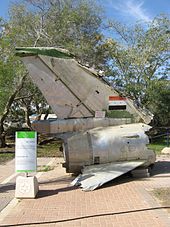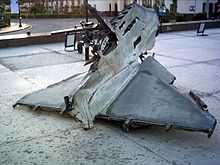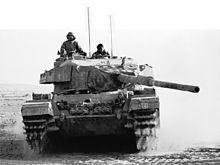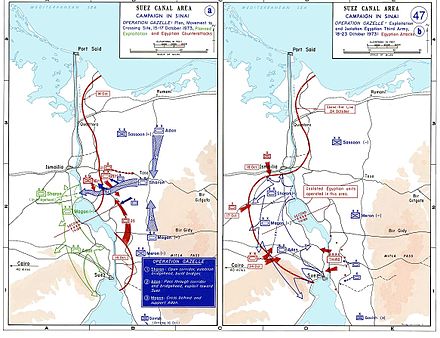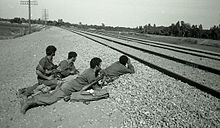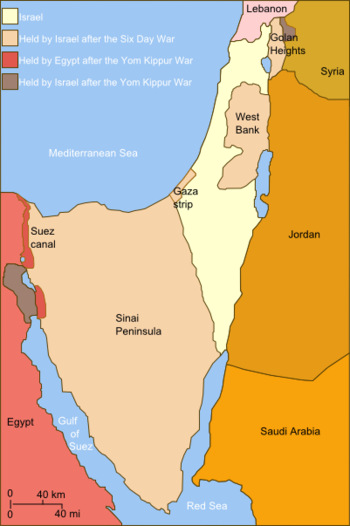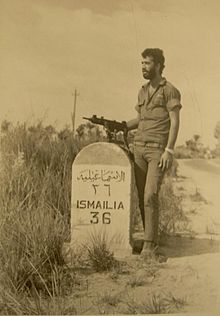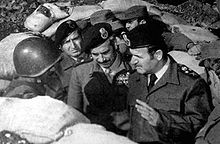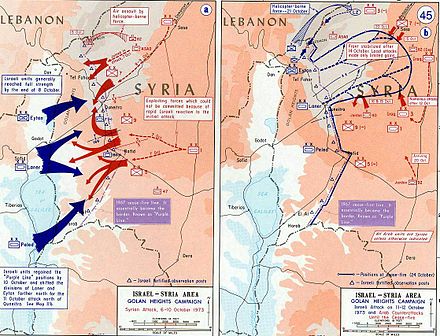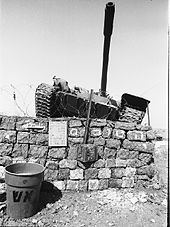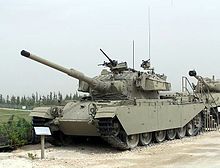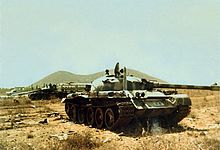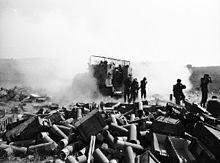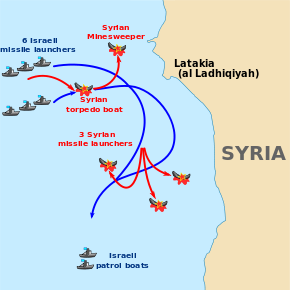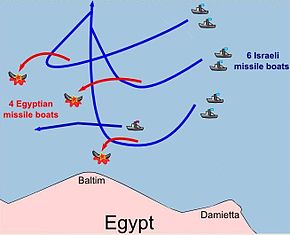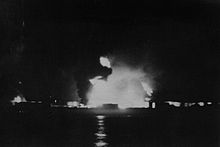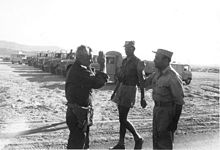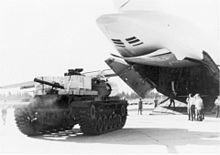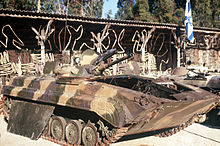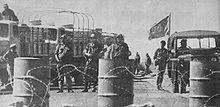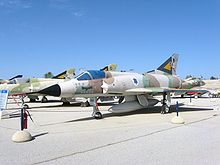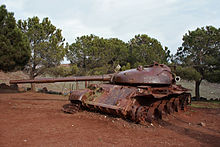
Yom Kippur War
Background to the schools Wikipedia
SOS Children have produced a selection of wikipedia articles for schools since 2005. SOS Child sponsorship is cool!
| Yom Kippur War/October War | |||||||
|---|---|---|---|---|---|---|---|
| Part of the Cold War and Arab–Israeli conflict | |||||||
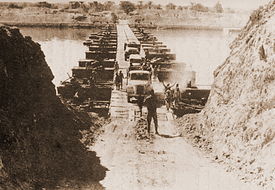 Egyptian forces crossing the Suez Canal on October 7 |
|||||||
|
|||||||
| Belligerents | |||||||
Arab Expeditionary Forces: Supported by: |
Supported by: |
||||||
| Commanders and leaders | |||||||
| Strength | |||||||
| Egypt: 650,000–800,000 troops 1,700 tanks (1,020 crossed) 2,400 armored carriers 1,120 artillery units 400 combat aircraft 140 helicopters 104 Navy vessels 150 surface to air missile batteries (62 in the front line) Syria: 150,000 troops 1,200 tanks 800–900 armored carriers 600 artillery units Expeditionary Forces*: 100,000 troops 500–670 tanks 700 armored carriers Cuba: 1,500–4,000 troops |
375,000–415,000 troops, 1,700 tanks, 3,000 armored carriers, 945 artillery units, 440 combat aircraft |
||||||
| Casualties and losses | |||||||
| 8,000–18,500 dead 18,000–35,000 wounded 8,783 captured 2,250–2,300 tanks destroyed or captured 341–514 aircraft destroyed 19 naval vessels sunk |
2,521–2,800 dead 7,250–8,800 wounded 293 captured 400 tanks destroyed 102 aircraft destroyed |
||||||
| * Not all participated in combat operations | |||||||
|
|||||
The Yom Kippur War, Ramadan War, or October War (Hebrew: מלחמת יום הכיפורים Milẖemet Yom HaKipurim or מלחמת יום כיפור Milẖemet Yom Kipur; Arabic: حرب أكتوبر ḥarb ʾUktōbar, or حرب تشرين ḥarb Tišrīn), also known as the 1973 Arab–Israeli War and the Fourth Arab–Israeli War, was a war of aggression fought by the coalition of Arab states led by Egypt and Syria against Israel from October 6 to 25, 1973.
The war began when the coalition launched a joint surprise attack on Israel on Yom Kippur, the holiest day in Judaism, which occurred that year during the Muslim holy month of Ramadan. Egyptian and Syrian forces crossed ceasefire lines to enter the Israeli-held Sinai Peninsula and Golan Heights respectively, which had been captured and occupied since the 1967 Six-Day War. Both the United States and the Soviet Union initiated massive resupply efforts to their respective allies during the war, and this led to a near-confrontation between the two nuclear superpowers.
The war began with a massive and successful Egyptian crossing of the Suez Canal. After crossing the cease-fire lines, Egyptian forces advanced virtually unopposed into the Sinai Peninsula. After three days, Israel had mobilized most of its forces and managed to halt the Egyptian offensive, settling into a stalemate. The Syrians coordinated their attack on the Golan Heights to coincide with the Egyptian offensive and initially made threatening gains into Israeli-held territory. Within three days, however, Israeli forces had managed to push the Syrians back to the pre-war ceasefire lines. They then launched a four-day counter-offensive deep into Syria. Within a week, Israeli artillery began to shell the outskirts of Damascus. As Egyptian president Anwar Sadat began to worry about the integrity of his major ally, he believed that capturing two strategic passes located deeper in the Sinai would make his position stronger during the negotiations. He therefore ordered the Egyptians to go back on the offensive, but the attack was quickly repulsed. The Israelis then counterattacked at the seam between the two Egyptian armies, crossed the Suez Canal into Egypt, and began slowly advancing southward and westward in over a week of heavy fighting which inflicted heavy casualties on both sides.
On October 22 a United Nations-brokered ceasefire quickly unraveled, with each side blaming the other for the breach. By October 24, the Israelis had improved their positions considerably and completed their encirclement of Egypt's Third Army and the city of Suez. This development led to tensions between the United States and the Soviet Union. As a result, a second ceasefire was imposed cooperatively on October 25 to end the war. At the conclusion of hostilities, Israeli forces were 40 kilometres (25 mi) from Damascus and 101 kilometres (63 mi) from Cairo.
The war had far-reaching implications. The Arab World, which had been humiliated by the lopsided rout of the Egyptian–Syrian–Jordanian alliance in the Six-Day War, felt psychologically vindicated by early successes in the conflict. In Israel, despite impressive operational and tactical achievements on the battlefield, the war effectively ended its sense of invincibility and complacency. The war also challenged many American assumptions; the United States initiated new efforts at mediation and peacemaking. These changes paved the way for the subsequent peace process. The Camp David Accords that followed led to the return of the Sinai to Egypt and normalized relations—the first peaceful recognition of Israel by an Arab country. Egypt continued its drift away from the Soviet Union and left the Soviet sphere of influence entirely.
Background
The war was part of the Arab–Israeli conflict, an ongoing dispute which included many battles and wars since 1948, when the state of Israel was formed. During the Six-Day War of 1967, Israel had captured Egypt's Sinai Peninsula and roughly half of Syria's Golan Heights.
According to Chaim Herzog:
On June 19, 1967, the National Unity Government of Israel voted unanimously to return the Sinai to Egypt and the Golan Heights to Syria in return for peace agreements. The Golan would have to be demilitarized and special arrangement would be negotiated for the Straits of Tiran. The government also resolved to open negotiations with King Hussein of Jordan regarding the Eastern border.
The Israeli decision was to be conveyed to the Arab states by the U.S. government. The U.S. was informed of the decision, but not that it was to transmit it. There is no evidence it was conveyed to Egypt or Syria. The decision was kept a closely guarded secret within Israeli government circles and the offer was withdrawn in October 1967.
Egypt and Syria both desired a return of the land lost in the Six-Day War. In September 1967, the Khartoum Arab Summit issued the "three no's", resolving that there would be "no peace, no recognition and no negotiation with Israel". In the years following the war, Israel erected lines of fortification in both the Sinai and the Golan Heights. In 1971, Israel spent $500 million fortifying its positions on the Suez Canal, a chain of fortifications and gigantic earthworks known as the Bar Lev Line, named after Israeli General Chaim Bar-Lev.
President Gamal Abdel Nasser of Egypt died in September 1970 and was succeeded by Anwar Sadat. In 1971, Sadat, in response to an initiative by UN intermediary Gunnar Jarring, declared that if Israel committed itself to "withdrawal of its armed forces from Sinai and the Gaza Strip", to "achievement of a just settlement for the refugee problem", to "the withdrawal of the Israeli armed forces from all the territories occupied since June 5, 1967", and to implementation of other provisions of UN Security Council Resolution 242 as requested by Jarring, Egypt would then "be ready to enter into a peace agreement with Israel." Israel responded that it would not withdraw to the pre-June 5, 1967 lines.
Sadat hoped that by inflicting even a limited defeat on the Israelis, the status quo could be altered. Hafez al-Assad, the leader of Syria, had a different view. He had little interest in negotiation and felt the retaking of the Golan Heights would be a purely military option. After the Six-Day War, Assad had launched a massive military buildup and hoped to make Syria the dominant military power of the Arab states. With the aid of Egypt, Assad felt that his new army could win convincingly against Israel and thus secure Syria's role in the region. Assad only saw negotiations beginning once the Golan Heights had been retaken by force, which would induce Israel to give up the West Bank and Gaza, and make other concessions.
Sadat also had important domestic concerns in wanting war. "The three years since Sadat had taken office... were the most demoralized in Egyptian history.... A desiccated economy added to the nation's despondency. War was a desperate option." In his biography of Sadat, Raphael Israeli argued that Sadat felt the root of the problem was in the great shame over the Six-Day War, and before any reforms could be introduced he felt that shame had to be overcome. Egypt's economy was in shambles, but Sadat knew that the deep reforms that he felt were needed would be deeply unpopular among parts of the population. A military victory would give him the popularity he needed to make changes. A portion of the Egyptian population, most prominently university students who launched wide protests, strongly desired a war to reclaim the Sinai and was highly upset that Sadat had not launched one in his first three years in office.
The other Arab states showed much more reluctance to fully commit to a new war. King Hussein of Jordan feared another major loss of territory as had occurred in the Six-Day War, in which Jordan lost all of the West Bank, territory it had conquered and annexed in 1948–49 which had doubled its population. Sadat was also backing the claim of the Palestine Liberation Organization (PLO) to the West Bank and Gaza and in the event of a victory promised Yasser Arafat that he would be given control of them. Hussein still saw the West Bank as part of Jordan and wanted it restored to his kingdom. Moreover, during the Black September crisis of 1970, a near civil war had broken out between the PLO and the Jordanian government. In that war, Syria had intervened militarily on the side of the PLO, estranging Hussein.
Iraq and Syria also had strained relations, and the Iraqis refused to join the initial offensive. Lebanon, which shared a border with Israel, was not expected to join the Arab war effort because of its small army and already evident instability. The months before the war saw Sadat engage in a diplomatic offensive to try to win support for the war. By the fall of 1973, he claimed the backing of more than a hundred states. These were most of the countries of the Arab League, Non-Aligned Movement, and Organization of African Unity. Sadat had also worked to curry favour in Europe and had some success before the war. Britain and France for the first time sided with the Arab powers against Israel on the United Nations Security Council.
Events leading up to the war
Following Israel's rejection of Sadat's peace initiative, which had proposed a full Israeli withdrawal to the pre-67 borders in exchange for a non-belligerency pact, Sadat declared that Egypt was prepared to "sacrifice a million Egyptian soldiers" to recover its lost territory. From the end of 1972, Egypt began a concentrated effort to build up its forces, receiving MiG-21 jet fighters, SA-2, SA-3, SA-6 and SA-7 antiaircraft missiles, T-55 and T-62 tanks, RPG-7 antitank weapons, and the AT-3 Sagger anti-tank guided missile from the Soviet Union and improving its military tactics, based on Soviet battlefield doctrines. Political generals, who had in large part been responsible for the rout in 1967, were replaced with competent ones.
The role of the superpowers, too, was a major factor in the outcome of the two wars. The policy of the Soviet Union was one of the causes of Egypt's military weakness. President Nasser was only able to obtain the material for an anti-aircraft missile defense wall after visiting Moscow and pleading with Kremlin leaders. He said that if supplies were not given, he would have to return to Egypt and tell the Egyptian people Moscow had abandoned them, and then relinquish power to one of his peers who would be able to deal with the Americans. The Americans would then have the upper hand in the region, which Moscow could not permit.
One of Egypt's undeclared objectives of the War of Attrition was to force the Soviet Union to supply Egypt with more advanced arms and materiel. Egypt felt the only way to convince the Soviet leaders of the deficiencies of most of the aircraft and air defense weaponry supplied to Egypt following 1967 was to put the Soviet weapons to the test against the advanced weaponry the United States had supplied to Israel.
Nasser's policy following the 1967 defeat conflicted with that of the Soviet Union. The Soviets sought to avoid a new conflagration between the Arabs and Israelis so as not to be drawn into a confrontation with the United States. The reality of the situation became apparent when the superpowers met in Oslo and agreed to maintain the status quo. This was unacceptable to Egyptian leaders, and when it was discovered that the Egyptian preparations for crossing the canal were being leaked, it became imperative to expel the Soviets from Egypt. In July 1972, Sadat expelled almost all of the 20,000 Soviet military advisers in the country and reoriented the country's foreign policy to be more favorable to the United States. The Syrians remained close to the Soviet Union.
The Soviets thought little of Sadat's chances in any war. They warned that any attempt to cross the heavily fortified Suez Canal would incur massive losses. Both the Soviets and the Americans were then pursuing détente, and had no interest in seeing the Middle East destabilized. In a June 1973 meeting with U.S. President Richard Nixon, Soviet leader Leonid Brezhnev had proposed Israel pull back to its 1967 border. Brezhnev said that if Israel did not, "we will have difficulty keeping the military situation from flaring up"—an indication that the Soviet Union had been unable to restrain Sadat's plans.
In an interview published in Newsweek (April 9, 1973), President Sadat again threatened war with Israel. Several times during 1973, Arab forces conducted large-scale exercises that put the Israeli military on the highest level of alert, only to be recalled a few days later. The Israeli leadership already believed that if an attack took place, the Israeli Air Force (IAF) could repel it.
Almost a full year before the war, in an October 24, 1972 meeting with his Supreme Council of the Armed Forces, Sadat declared his intention to go to war with Israel even without proper Soviet support. Planning had begun in 1971 and was conducted in absolute secrecy—even the upper-echelon commanders were not told of war plans until less than a week prior to the attack, and the soldiers were not told until a few hours beforehand. The plan to attack Israel in concert with Syria was code-named Operation Badr (Arabic for "full moon"), after the Battle of Badr, in which Muslims under Muhammad defeated the Quraish tribe of Mecca.
Lead-up to the surprise attack
The Israel Defense Forces (IDF) Directorate of Military Intelligence's (abbreviated as "Aman") Research Department was responsible for formulating Israel's intelligence estimate. Their assessments on the likelihood of war were based on several assumptions. First, it was assumed correctly that Syria would not go to war with Israel unless Egypt did so as well. Second, the department learned from Ashraf Marwan, former Presidents Nasser's son in law who was a senior Mossad agent that Egypt wanted to regain all of the Sinai, but would not go to war until they were supplied MiG-23 fighter-bombers to neutralize the Israeli Air Force, and Scud missiles to be used against Israeli cities as a deterrent against Israeli attacks on Egyptian infrastructure.
Since they had not received MiG-23s, and Scud missiles had only arrived in Egypt from Bulgaria in late August and it would take four months to train the Egyptian ground crews, Aman predicted war with Egypt was not imminent. This assumption about Egypt's strategic plans, known as "the concept", strongly prejudiced the department's thinking and led it to dismiss other war warnings.
By mid-1973, Aman was almost completely aware of the Arab war plans. It knew that the Egyptian Second and Third Armies would attempt to cross the Suez Canal and advance ten kilometers into the Sinai, followed by armored divisions which would advance towards the Mitla and Gidi passes, and that naval units and paratroopers would then attempt to capture Sharm el-Sheikh. Aman was also aware of many details of the Syrian war plan. However, Israeli analysts, following "the concept", did not believe the Arabs were serious about going to war.
The Egyptians did much to further this misconception. Both the Israelis and the Americans felt that the expulsion of the Soviet military observers had severely reduced the effectiveness of the Egyptian army. The Egyptians ensured that there was a continual stream of false information on maintenance problems and a lack of personnel to operate the most advanced equipment. The Egyptians made repeated misleading reports about lack of spare parts that also made their way to the Israelis. Sadat had so long engaged in brinkmanship that his frequent war threats were being ignored by the world.
In April and May 1973, Israeli intelligence began picking up clear signals of Egypt's intentions for war, recognizing that it had the necessary divisions and bridging equipment to cross the Suez Canal, and a missile umbrella to protect any crossing operation from air attack. However, Aman Chief Eli Zeira was still confident that the probability of war was low.
In May and August 1973, the Egyptian Army conducted military exercises near the border, and Ashraf Marwan inaccurately warned that Egypt and Syria would launch a surprise attack on May 15. The Israeli Army mobilized in response to both exercises at considerable cost. These exercises were to ensure that the Israelis would dismiss the actual war preparations right before the attack was launched as another exercise.
Egyptian and Syrian military exercises
For the week leading up to Yom Kippur, the Egyptian army staged a week-long training exercise adjacent to the Suez Canal. Israeli intelligence, detecting large troop movements towards the canal, dismissed these movements as mere training exercises. Movements of Syrian troops towards the border were also detected, as were cancellation of leaves and a call-up of reserves in the Syrian army. These activities were considered puzzling, but not a threat because, Aman believed, they would not attack without Egypt and Egypt would not attack until the weaponry they wanted arrived. Despite this belief, Israel sent reinforcements to the Golan Heights. These forces were to prove critical during the early days of the war.
On September 27 and 30, two batches of reservists were called up by the Egyptian army to participate in these exercises. Two days before the outbreak of the war, on October 4, the Egyptian command publicly announced the demobilization of part of the reservists called up during September 27 to lull suspicion on the Israeli side. Around 20,000 troops were demobilized, and subsequently some of these men were given leave to perform the Umrah (pilgrimage) to Mecca. Reports were also given instructing cadets in military colleges to resume their courses on October 9.
On October 1, an Aman researcher, Lieutenant Binyamin Siman-Tov, submitted an assessment arguing that that the Egyptian deployments and exercises along the Suez Canal seemed to be a camouflage for an actual crossing of the canal. Siman-Tov sent a more comprehensive assessment on October 3. Both were ignored by his superior.
According to General El-Gamasy, "On the initiative of the operations staff, we reviewed the situation on the ground and developed a framework for the planned offensive operation. We studied the technical characteristics of the Suez Canal, the ebb and the flow of the tides, the speed of the currents and their direction, hours of darkness and of moonlight, weather conditions, and related conditions in the Mediterranean and Red sea." He explained further by saying, "Saturday 6 October 1973 (10 Ramadan 1393) was the day chosen for the September–October option. Conditions for a crossing were good, it was a feast day in Israel, and the moon on that day, 10 Ramadan, shone from sunset until midnight." The war coincided that year with the Muslim month of Ramadan, when many Arab Muslim soldiers also fast. On the other hand, the fact that the attack was launched on Yom Kippur may have helped Israel to more easily marshal reserves from their homes and synagogues, because roads and communication lines were largely open and this eased mobilizing and transporting the military.
Despite refusing to participate, King Hussein of Jordan "had met with Sadat and Assad in Alexandria two weeks before. Given the mutual suspicions prevailing among the Arab leaders, it was unlikely that he had been told any specific war plans. But it was probable that Sadat and Assad had raised the prospect of war against Israel in more general terms to feel out the likelihood of Jordan joining in."
On the night of September 25, Hussein secretly flew to Tel Aviv to warn Israeli Prime Minister Golda Meir of an impending Syrian attack. "Are they going to war without the Egyptians, asked Mrs. Meir. The king said he didn't think so. 'I think they [Egypt] would cooperate.'" This warning was ignored, and Aman concluded that the king had not told anything that was not already known. Throughout September Israel received eleven warnings of war from well-placed sources. However, Mossad Director-General Zvi Zamir continued to insist that war was not an Arab option, even after Hussein's warning. Zamir would later remark that "We simply didn't feel them capable [of War]."
On the day before the war, General Ariel Sharon was shown aerial photographs and other intelligence by Yehoshua Saguy, his divisional intelligence officer. General Sharon noticed that the concentration of Egyptian forces along the canal was far beyond anything observed during the training exercises, and that the Egyptians had amassed all of their crossing equipment along the canal. He then called General Shmuel Gonen, who replaced him as head of Southern Command, and expressed his certainty that war was imminent.
On October 4–5, Zamir's concern grew as additional signs of an impending attack were detected. Soviet advisers and their families left Egypt and Syria, transport aircraft thought to be laden with military equipment landed in Cairo and Damascus, and aerial photographs revealed that Egyptian and Syrian concentrations of tanks, infantry and SAM missiles were at an unprecedented high. According to declassified documents from the Agranat Commission Brigadier General Yisrael Lior who was Prime Minister Golda Meir's military claimed that Mossad knew from Ashraf Marwan that an attack was going to occur under the guise of a military drill a week before it occurred, but the information the process of passing along the information to the Prime Ministers office failed. The information ended up with Mossad head Zvi Zamir's aide who passed it along to Zamir at 12:30AM 5 October. According to the claim an unfocused and groogy Zamir thanked the aide for the information and said he would pass it along to the Prime Ministers office in the morning. On the night of October 5/6, Zamir personally went to Europe to meet with Marwan at midnight. Marwan informed him that a joint Syrian-Egyptian attack was imminent. However, Marwan incorrectly told Zamir that the attack would take place at sunset.
It was this warning in particular, combined with the large number of other warnings, that finally goaded the Israeli High Command into action. Just hours before the attack began, orders went out for a partial call-up of the Israeli reserves. Ironically, calling up the reserves proved to be easier than usual, as almost all of the troops were at synagogue or at home for the holiday.
The attack by the Egyptian and Syrian forces caught the United States by surprise. According to the future CIA Director and Defense Secretary Robert Gates, he was briefing a US arms negotiator on the improbability of armed conflict in the region when he heard the news of the outbreak of war on the radio. On the other hand, the KGB learned about the attack in advance, probably from its intelligence sources in Egypt.
Lack of Israeli pre-emptive attack
The Israeli strategy was, for the most part, based on the precept that if war was imminent, Israel would launch a pre-emptive strike. It was assumed that Israel's intelligence services would give, in the worst case, about 48 hours notice prior to an Arab attack.
Golda Meir, Moshe Dayan, and General David Elazar met at 8:05 am the morning of Yom Kippur, six hours before the war began. Dayan opened the meeting by arguing that war was not a certainty. Elazar then presented his argument in favour of a pre-emptive attack against Syrian airfields at noon, Syrian missiles at 3:00 pm, and Syrian ground forces at 5:00 pm "When the presentations were done, the prime minister hemmed uncertainly for a few moments but then came to a clear decision. There would be no preemptive strike. Israel might be needing American assistance soon and it was imperative that it would not be blamed for starting the war. 'If we strike first, we won't get help from anybody', she said."
Other developed nations, being more dependent on OPEC oil, took more seriously the threat of an Arab oil embargo and trade boycott, and had stopped supplying Israel with munitions. As a result, Israel was totally dependent on the United States for military resupply, and particularly sensitive to anything that might endanger that relationship. After Meir made her decision, at 10:15 am she met with US ambassador Kenneth Keating in order to inform the United States that Israel did not intend to preemptively start a war, and asked that US efforts be directed at preventing war. An electronic telegram with Keating's report on the meeting was sent to the US at 16:33 GMT (6:33 pm local time).
A message arrived later from United States Secretary of State Henry Kissinger saying, "Don't preempt." At the same time, Kissinger also urged the Soviets to use their influence to prevent war, contacted Egypt with Israel's message of non-preemption, and sent messages to other Arab governments to enlist their help on the side of moderation. These late efforts were futile. According to Henry Kissinger, had Israel struck first, it would not have received "so much as a nail."
David Elazar proposed a mobilization of the entire Air Force and four armored divisions, a total of 100,000 to 120,000 troops, while Dayan favored a mobilization of the Air Force and two armored divisions, totaling around 70,000 troops. Meir chose Elazar's proposal.
Combat operations
In the Sinai
The Sinai was once again the arena of conflict between the Israelis and the Egyptians, the fifth such occasion. The Egyptians had prepared for an assault across the canal and deployed five divisions totaling 100,000 soldiers, 1,350 tanks and 2,000 guns and heavy mortars for the onslaught. Facing them were 450 soldiers of the Jerusalem Brigade, spread out in 16 forts along the length of the Canal. There were 290 Israeli tanks in all of Sinai divided into three armored brigades, and only one of these was deployed near the Canal when hostilities commenced.
Large bridgeheads were established on the east bank on October 6. Israeli armoured forces launched counterattacks from October 6 to 8, but they were often piecemeal and inadequately supported and were beaten back principally by Egyptians using portable anti-tank missiles.
The Egyptian units generally would not advance beyond a shallow strip for fear of losing the protection of their surface-to-air missile (SAM) batteries, which were situated on the west bank of the canal. In the Six-Day War, the Israeli Air Force had pummelled the defenseless Arab armies. Egypt (and Syria) had heavily fortified their side of the ceasefire lines with SAM batteries provided by the Soviet Union, against which the Israeli Air Force had no time to execute a Suppression of Enemy Air Defenses (SEAD) operation due to the element of surprise. Israel, which had invested much of its defense budget building the region's strongest air force, would see the effectiveness of its air force curtailed in the initial phases of the conflict by the SAM presence.
On October 9, the IDF chose to concentrate its reserves and build up its supplies while the Egyptians remained on the strategic defensive. It was decided to counterattack once Egyptian armour attempted to expand the bridgehead beyond the protective SAM umbrella. The riposte, codenamed Operation Gazelle, was launched on October 15. IDF forces spearheaded by Ariel Sharon's division broke through the Tasa corridor and crossed the Suez Canal to the north of the Great Bitter Lake.
After intense fighting, Israeli progress towards Cairo was brought to a halt while the IDF advanced southwards on the east bank of the Great Bitter Lake and in the southern extent of the canal right up to Port Suez when the ceasefire was declared on October 24.
Egyptian attack
Anticipating a swift Israeli armored counterattack by three armored divisions, the Egyptians had armed their assault force with large numbers of man-portable anti-tank weapons— rocket-propelled grenades and the less numerous but more advanced Sagger guided missiles, which proved devastating to the first Israeli armored counterattacks. Each of the five infantry divisions that was to cross the canal had been equipped with RPG-7 rockets and RPG-43 grenades, and reinforced with an anti-tank guided missile battalion, as they would not have any armor support for nearly 12 hours.
In addition, the Egyptians had built separate ramps at the crossing points, reaching as high as 21 metres (69 ft) to counter the Israeli sand wall, provide covering fire for the assaulting infantry and to counter the first Israeli armored counterattacks. The scale and effectiveness of the Egyptian strategy of deploying these anti-tank weapons coupled with the Israelis' inability to disrupt their use with close air support (due to the SAM shield) greatly contributed to Israeli setbacks early in the war.
The Egyptian Army put great effort into finding a quick and effective way of breaching the Israeli defenses. The Israelis had built large 18 meter (59 foot) high sand walls with a 60 degree slope and reinforced with concrete at the water line. Egyptian engineers initially experimented with explosive charges and bulldozers to clear the obstacles, before a junior officer proposed using high pressure water cannons. The idea was tested and found to be a sound one, and several high pressure water cannons were imported from Britain and East Germany. The water cannons effectively breached the sand walls using water from the canal.
At 2:00 pm on October 6, Operation Badr began with a large airstrike. More than 200 Egyptian aircraft conducted simultaneous strikes against three airbases, Hawk missile batteries, three command centers, artillery positions, and several radar installations. Airfields at Refidim and Bir Tamada were temporarily put out of service, and damage was inflicted on a Hawk battery at Ophir. The aerial assault was coupled with a barrage from more than 2,000 artillery pieces for a period of 53 minutes against the Bar Lev Line and rear area command posts and concentration bases.
Author Andrew McGregor claimed that the success of the first strike negated the need for a second planned strike. Egypt acknowledged the loss of 5 aircraft during the attack. However, Kenneth Pollack wrote that 18 Egyptian aircraft were shot down, and that these losses prompted the cancellation of the second planned wave. In one notable engagement during this period, a pair of Israeli F-4E Phantoms challenged 28 Egyptian MiGs over Sharm el-Sheikh and within half an hour, shot down between seven and eight MiGs with no losses. One of the Egyptian pilots killed was Captain Atif Sadat, President Sadat's half-brother.
Simultaneously, 14 Egyptian Tupolev Tu-16 bombers attacked Israeli targets in the Sinai with Kelt missiles, while another two other Egyptian Tupolevs fired two Kelt missiles at a radar station in central Israel. One missile was shot down by a patrolling Israeli Mirage fighter, and the second fell into the sea. The attack was an attempt to warn Israel that Egypt could retaliate if it bombed targets deep in Egyptian territory.
Under cover of the initial artillery barrage, the Egyptian assault force of 32,000 infantry began crossing the canal in twelve waves at five separate crossing areas, from 14:05 to 17:30, in what became known as The Crossing. The Egyptians prevented Israeli forces from reinforcing the Bar Lev Line and proceeded to attack the Israeli fortifications. Meanwhile engineers crossed over to breach the sand wall. The Israeli Air Force conducted air interdiction operations to try to prevent the bridges from being erected, but took losses from Egyptian SAM batteries. The air attacks were overall ineffective, as the sectional design of the bridges enabled quick repair when hit.
Despite fierce resistance, the Israeli reserve brigade garrisoning the Bar-Lev forts was overwhelmed. According to Shazly, within six hours, fifteen strongpoints had been captured as Egyptian forces advanced several kilometers unto the Sinai. Shazly's account was disputed by Kenneth Pollack, who noted that for the most part, the forts only fell to repeated assaults by superior forces or prolonged sieges over many days. The northernmost fortification of the Bar Lev Line, code-named ' Fort Budapest', withstood repeated assaults and remained in Israeli hands throughout the war. Once the bridges were laid, additional infantry with the remaining portable and recoilless anti-tank weapons began to cross the canal, while the first Egyptian tanks started to cross at 20:30.
The Egyptians also attempted to land several heli-borne commando units in various areas in the Sinai to hamper the arrival of Israeli reserves. However, this attempt met with disaster as the Israelis shot down up to twenty helicopters, inflicting heavy casualties. Israeli Major General (res.) Chaim Herzog placed Egyptian helicopter losses at fourteen. Still, other sources claim that “several” helicopters were downed with “total loss of life” and that the few commandos that did filter through were ineffectual and presented nothing more than a “nuisance.” However, Kenneth Pollack asserted that despite their heavy losses, the Egyptian commandos fought exceptionally hard and created considerable panic, prompting the Israelis to take precautions which hindered their ability to concentrate on stopping the assault across the canal.
Egyptian forces advanced approximately 4 to 5 km into the Sinai Desert with two armies (both corps-sized by western standards, included the 2nd Infantry Division in the northern Second Army). By the following morning, some 850 tanks had crossed the canal. In his account of the war, Saad El Shazly noted that by the morning of October 7, the Egyptians had lost 280 soldiers killed and 20 tanks destroyed, though this account is disputed.
Most Israeli soldiers defending the Bar-Lev Line were casualties, and some 200 were taken prisoner. In the subsequent days, some defenders of the Bar-Lev Line managed to break through Egyptian encirclement and return to their lines, or were extracted during Israeli counterattacks that came later on. For the next several days, the Israeli Air Force (IAF) played a minimal role in the fighting largely because it was needed to deal with the simultaneous, and ultimately more threatening, Syrian invasion of the Golan Heights.
Egyptian forces then consolidated their initial positions. On October 7, the bridgeheads were enlarged an additional 4 km, at the same time repulsing Israeli counterattacks. In the north, the Egyptian 18th Division attacked the town of Qantara, enaging Israeli forces in and around the town. The fighting there was conducted at close quarters, and was sometimes hand-to-hand. The Egyptians were forced to clear the town building by building. By evening, most of the town was in Egyptian hands. Qantara was completely cleared by the next morning.
Meanwhile the Egyptian commandos airdropped on October 6 began encountering Israeli reserves the following morning. Both sides suffered heavy losses, but the commandos were at times successful in delaying the movement of Israeli reserves to the front. These special operations often led to confusion and anxiety among Israeli commanders, who commended the Egyptian commandos. However, this view was contradicted by another source which stated that few commandos made it to their objectives, and were usually nothing more than a nuisance. According to Abraham Rabinovich, only the commandos near Baluza and those blocking the road to Fort Budapest had measurable successes. Of the 1,700 Egyptian commandos inserted behind Israeli lines during the war, 740 were killed — many in downed helicopters — and 330 taken prisoner.
Israeli counter-attack
On October 7, David Elazar visited Shmuel Gonen, commander of the Israeli Southern front—who had only taken the position three months before at the retirement of Ariel Sharon—and met with Israeli commanders. The Israelis planned a cautious counterattack for the following day by Abraham Adan's 162nd Armored Division. The same day, the Israeli Air Force carried out Operation Tagar, aiming to neutralize Egyptian Air Force bases and its missile defense shield.
Seven Egyptian airbases were damaged with the loss of two A-4 Skyhawks and their pilots. Two more planned attacks were called off due to the increasing need for airpower on the Syrian front. The IAF carried out additional air attacks against Egyptian forces on the east bank of the canal, reportedly inflicting heavy losses. Israeli jets had carried out hundreds of sorties against Egyptian targets by the following day, but the Egyptian SAM shield had taken a toll, and losses had mounted to three aircraft for every 200 sorties, a rate which was unsustainable. The Israelis responded by rapidly devising new tactics to thwart Egyptian air defenses.
On October 8, after Elazar had left, Gonen changed the plans on the basis of over-optimistic field reports. Adan's division was composed of three brigades totaling 183 tanks. One of the brigades was in still en route to the area, and would participate in the attack by noon, along with a supporting mechanized infantry brigade with an additional 44 tanks. The Israeli counterattack was in the direction of the Bar Lev strongpoints opposite the city of Ismailia, against entrenched Egyptian infantry. In a series of ill-coordinated attacks, which were met by stiff resistance, the Israelis suffered heavy losses.
That afternoon, Egyptian forces advanced once more to deepen their bridgeheads, and as a result the Israelis lost several strategic positions. Further Israeli attacks to regain the lost ground proved futile. Towards nightfall, an Egyptian counterattack was repulsed with the loss of 50 tanks by the Israeli 143rd Armoured Division, which was led by General Ariel Sharon, who had been reinstated as a division commander at the outset of the war. Garwych, citing Egyptian sources, documented Egyptian tank losses up to October 13 at 240.
According to Herzog, by October 9 the front lines had stabilized. The Egyptians were unable to advance further, and Egyptian armored attacks on October 9 and 10 were repulsed with heavy losses. However, this claim was disputed by Shazly, who claimed that the Egyptians continued to advance and improve their positions well into October 10. He pointed to one engagement, which involved elements of the 1st Infantry Brigade, attached to the 19th Division, which captured Ayoun Mousa, south of Suez.
Both Herzog and Shazly mentioned a failed Egyptian attack southward along the Gulf of Suez in the direction of Ras Sudar by the Egyptian 1st Mechanized Brigade. Leaving the safety of the SAM umbrella, the force was attacked by Israeli aircraft and suffered severe losses. Shazly cited this experience as a basis to resist pressure by Minister of War, General Ahmad Ismail Ali to attack eastward toward the Mitla and Gidi Passes.
Between October 10 and 13, both sides refrained from any large-scale actions, and the situation was relatively stable. Both sides launched small-scale attacks, and the Egyptians used helicopters to land commandos behind Israeli lines. Some Egyptian helicopters were shot down, and those commando forces that managed to land were quickly destroyed by Koah Patzi, a twelve-man squad consisting of officers from the Sayeret Shaked unit. In one key engagement on October 13, Koah Patzi destroyed a particularly large incursion and killed close to a hundred Egyptian commandos.
With the situation on the Syrian front stabilizing, the Israeli High Command agreed that the time was ripe for an Israeli counterattack and strike across the canal. General Sharon advocated an immediate crossing at Deversoir at the northern edge of Great Bitter Lake. On October 9, a reconnaissance force attached to Colonel Amnon Reshef's Brigade detected a gap between the Egyptian Second and Third armies in this sector. Chief of Staff Elazar and General Chaim Bar-Lev, who had by now replaced Gonen as Chief of Southern Command, agreed that this was the ideal spot for a crossing. However, given the size of the Egyptian armoured reserves, the Israelis chose to wait for an opportunity which would allow them to reduce Egyptian armored strength before initiating any crossing.
The opportunity arrived on October 12, when Israeli intelligence detected signs that the Egyptians were gearing up for a major armored thrust. This was precisely the moment the Israelis were waiting for. They could finally utilize their advantages in speed, maneuver and tank gunnery, areas in which they excelled. Once Egyptian armored strength was sufficiently degraded, the Israelis would commence their own canal crossing. General Shazly strongly opposed any eastward advance that would leave his armor without adequate air cover. He was overruled by General Ismail and Sadat, whose aims were to seize the strategic Mitla and Gidi Passes and the Israeli nerve centre at Refidim, which they hoped would relieve pressure on the Syrians (who were by now on the defensive) by forcing Israel to shift divisions from the Golan to the Sinai.
The 2nd and 3rd Armies were ordered to attack eastward in six simultaneous thrusts over a broad front, leaving behind five infantry divisions to hold the bridgeheads. The attacking forces, consisting of 800-1,000 tanks would not have SAM cover, so the Egyptian Air Force (EAF) was tasked with the defense of these forces from Israeli air attacks. Armored and mechanized units began the attack on October 14 with artillery support. They were up against 700-750 Israeli tanks.
Preparatory to the tank attack, Egyptian helicopters set down 100 commandos near the Lateral Road to disrupt the Israeli rear. An Israeli reconnaissance unit quickly subdued them, killing 60 and taking numerous prisoners. Still bruised by the extensive losses their commandos had suffered on the opening day of the war, the Egyptians were unable or unwilling to implement further commando operations that had been planned in conjunction with the armored attack. The Egyptian armored thrust suffered heavy losses. Instead of concentrating forces of maneuvering, except for the wadi thrust, Egyptian units launched head-on-attacks against the waiting Israeli defenses.
Kenneth Pollack credited a successful Israeli commando raid early on October 14 against an Egyptian signals-intercept site at Jebel Ataqah with seriously disrupting Egyptian command and control and contributing to its breakdown during the engagement. The Egyptian attack was decisively repelled. At least 250 Egyptian tanks and some 200 armored vehicles were destroyed. Egyptian casualties exceeded 1,000. Fewer than 40 Israeli tanks were hit and all but six of them were repaired by Israeli maintenance crews and returned to service. Israeli casualties were light.
Israeli breakthrough
The Israelis immediately followed their success of October 14 with a multidivisional counterattack through the gap between the Egyptian 2nd and 3rd Armies, which had been detected by an American SR-71 Spyplane. Sharon's 143rd Division, now reinforced with a paratroop brigade commanded by Colonel Danny Matt, was tasked with establishing bridgeheads on the east and west banks of the canal. The 162nd and 252nd Armored Divisions, commanded by Generals Avraham Adan and Kalman Magen respectively, would then cross through the breach to the west bank of the canal and swing southward, encircling the 3rd Army. The offensive was code-named Operation Stouthearted Men or alternatively, Operation Valiant.
On the night of October 15, 750 of Colonel Matt's paratroopers crossed the canal in rubber dinghies. They were soon joined by tanks ferried on motorized rafts and additional infantry. The force encountered no resistance initially and fanned out in raiding parties, attacking supply convoys, SAM sites, logistic centers and anything of military value, with priority given to the SAMs. Attacks on SAM sites punched a hole in the Egyptian anti-aircraft screen and enabled the Israeli Air Force to more aggressively strike Egyptian ground targets.
On the night of October 15, 20 Israeli tanks and 7 APCs under the command of Colonel Haim Erez crossed the canal and penetrated 12 kilometers into mainland Egypt, taking the Egyptians by surprise. For the first 24 hours, Erez's force attacked SAM sites and military columns with impunity. On the morning of October 17, it was attacked by the 23rd Egyptian Armored Brigade, but managed to repulse the attack. By this time, the Syrians no longer posed a credible threat and the Israelis were able to shift their air power to the south in support of the offensive. The combination of a weakened Egyptian SAM umbrella and a greater concentration of Israeli fighter-bombers meant that the IAF was capable of greatly increasing sorties against Egyptian military targets, including convoys, armor and airfields. The Egyptian bridges across the canal were damaged in Israeli air and artillery attacks.
Israeli jets began attacking Egyptian SAM sites and radars, prompting General Ismail to withdraw much of the Egyptians' air defense equipment. This in turn gave the IAF greater freedom to operate in Egyptian airspace. Israeli jets also attacked and destroyed underground communication cables at Banha in the Nile Delta, forcing the Egyptians to transmit selective messages by radio, which could be intercepted. Aside from the cables at Banha, Israel refrained from attacking economic and strategic infrastructure following an Egyptian threat to retaliate against Israeli cities with Scud missiles. Israeli aircraft bombed Egyptian Scud batteries at Port Said several times. The Egyptian Air Force attempted to interdict IAF sorties and attack Israeli ground forces, but suffered heavy losses in dogfights and from Israeli air defenses, while inflicting light aircraft losses on the Israelis. The heaviest air battles took place over the northern Nile Delta, where the Israelis repeatedly attempted to destroy Egyptian airbases.
Despite the success the Israelis were having on the west bank, Generals Bar-Lev and Elazar ordered Sharon to concentrate on securing the bridgehead on the east bank. He was ordered to clear the roads leading to the canal as well as a position known as the Chinese Farm, just north of Deversoir, the Israeli crossing point. Sharon objected and requested permission to expand and breakout of the bridgehead on the west bank, arguing that such a maneuver would cause the collapse of Egyptian forces on the east bank. But the Israeli high command was insistent, believing that until the east bank was secure, forces on the west bank could be cut off. Sharon was overruled by his superiors and relented.
On October 16, he dispatched Amnon Reshef's Brigade to attack the Chinese Farm. Other IDF forces attacked entrenched Egyptian forces overlooking the roads to the canal. After three days of bitter and close-quarters fighting, the Israelis succeeded in dislodging the numerically superior Egyptian forces. The Israelis lost about 300 dead, 1,000 wounded, and 56 tanks. The Egyptians suffered heavier casualties, and lost 118 tanks destroyed and 15 captured.
Israeli forces across the Suez
Egyptians meanwhile failed to grasp the extent and magnitude of the Israeli crossing nor did they appreciate its intent and purpose. This was partly due to attempts by Egyptian field commanders to obfuscate reports concerning the Israeli crossing and partly due to a false assumption that the canal crossing was merely a diversion for a major IDF offensive targeting the right flank of the Second Army. Consequently, on October 16, General Shazly ordered the 21st Armored Division to attack southward and the T-62-equipped 25th Independent Armored Brigade to attack northward in a pincer action to eliminate the perceived threat to the Second Army.
The Egyptians failed to scout the area and were unaware that by now, Adan's 162nd Armored Division was in the vicinity. Moreover, the 21st and 25th failed to coordinate their attacks, allowing General Adan's Division to meet each force individually. Adan first concentrated his attack on the 21st Armored Division, destroying 50–60 Egyptian tanks and forcing the remainder to retreat. He then turned southward and ambushed the 25th Independent Armored Brigade, destroying 86 of its 96 tanks and all of its APCs while losing 3 tanks.
Egyptian artillery shelled the Israeli bridge over the canal on the morning of October 17, scoring several hits. The Egyptian Air Force launched repeated raids, some with up to twenty aircraft, to take out the bridge and rafts, damaging the bridge. The Egyptians had to shut down their SAM sites during these raids, allowing Israeli fighters to intercept the Egyptians. The Egyptians lost 16 planes and 7 helicopters, while the Israelis lost 6 planes.
The bridge was damaged, and the Israeli Paratroop Headquarters, which was near the bridge, was also hit, wounding the commander and his deputy. During the night, the bridge was repaired, but only a trickle of Israeli forces crossed. According to Chaim Herzog, the Egyptians continued attacking the bridgehead until the cease-fire, using artillery and mortars to fire tens of thousands of shells into the area of the crossing. Egyptian aircraft attempted to bomb the bridge every day, and helicopters launched suicide missions, making attempts to drop barrels of napalm on the bridge and bridgehead. The bridges were damaged multiple times, and had to be repaired at night. The attacks caused heavy casualties, and many tanks were sunk when their rafts were hit. Egyptian commandos and frogmen with armored support launched a ground attack against the bridgehead, which was repulsed with the loss of 10 tanks. Two subsequent Egyptian counterattacks were also beaten back.
After the failure of the October 17 counterattacks, the Egyptian General Staff slowly began to realize the magnitude of the Israeli offensive. Early on October 18, the Soviets showed Sadat satellite imagery of Israeli forces operating on the west bank. Alarmed, Sadat dispatched Shazly to the front to assess the situation first hand. He no longer trusted his field commanders to provide accurate reports. Shazly confirmed that the Israelis had at least one division on the west bank and were widening their bridgehead. He advocated withdrawing most of Egypt's armor from the east bank to confront the growing Israeli threat on the west bank. Sadat rejected this recommendation outright and even threatened Shazly with a court martial. Ahmad Ismail Ali recommended that Sadat push for a cease-fire so as to prevent the Israelis from exploiting their successes.
Israeli forces were by now pouring across the canal on two bridges, including one of indigenous design, and motorized rafts. Israeli engineers under Brigadier-General Dan Even had worked under heavy Egyptian fire to set up the bridges, and over 100 were killed and hundreds more wounded. The crossing was difficult due to Egyptian artillery fire, though by 4:00 am, two of Adan's brigades were on the west bank of the canal. On the morning of October 18, Sharon's forces on the west bank launched an offensive toward Ismailia, slowly pushing back the Egyptian paratroop brigade occupying the sand rampart northward to enlarge the bridgehead. Some of his units attempted to move west, but were stopped at the crossroads in Nefalia. Adan's division rolled south toward Suez City while Magen's division pushed west toward Cairo and south toward Adabiya. On October 19, one of Sharon's brigades continued to push the Egyptian paratroopers north towards Ismailia until the Israelis were within five or six miles of the city. Sharon hoped to seize the city and thereby sever the logistical and supply lines for most of the Egyptian Second Army. Sharon's second brigade began to cross the canal. The brigade's forward elements moved to the Abu Sultan Camp, from where they moved north to take Orcha, an Egyptian logistics base defended by a commando battalion. Israeli infantrymen cleared the trenches and bunkers, often engaging in hand-to-hand combat, as tanks moved alongside them and fired into the trench sections to their front. The position was secured before nightfall. More than 300 Egyptians were killed and 50 taken prisoner, while the Israelis lost 18 dead. The fall of Orcha caused the collapse of the Egyptian defensive line, allowing more Israeli troops to get onto the sand rampart. There, they were able to fire in support of Israeli troops facing Missouri Ridge, an Egyptian-occupied position on the Bar-Lev Line which could pose a threat to the Israeli crossing. On the same day, Israeli paratroopers participating in Sharon's drive pushed the Egyptians back far enough for the Israeli bridges to be out of sight of Egyptian artillery observers, though the Egyptians continued shelling the area.
As the Israelis pushed towards Ismailia, the Egyptians fought a delaying battle, falling into defensive positions further north as they came under increasing pressure from the Israeli ground offensive, coupled with airstrikes. On October 21, one of Sharon's brigades was occupying the city's outskirts, but facing fierce resistance from Egyptian paratroopers and commandos. The same day, Sharon's last remaining unit on the east bank attacked Missouri Ridge. Shmuel Gonen had demanded Sharon capture the position, and Sharon had reluctantly ordered the attack. The assault was preceded by an air attack which caused hundreds of Egyptian soldiers to flee and thousands of others to dig in. One battalion then attacked from the south, destroying 20 tanks and overrunning infantry positions before being halted by Sagger rockets and minefields. Another battalion attacked from southwest, and was stopped by fortified infantry. The Israelis managed to occupy one-third of Missouri Ridge. Defense Minister Moshe Dayan countermanded orders from Sharon's superiors to continue the attack. However, the Israelis continued to expand their holdings on the east bank. According to the Israelis, the IDF bridgehead was 25 miles wide and 20 miles deep by the end of October 21.
On October 22, Ismailia's Egyptian defenders were occupying their last line of defense, but managed to repel an Israeli attempt to get behind Ismailia and encircle the city, then push some of Sharon's forward troops back to the Sweetwater Canal. The Israeli advance on Ismailia had been stopped 10 km south of the city. Both sides had suffered heavy losses.
On the northern front, the Israelis also attacked Port Said, facing Egyptian troops and a 900-strong Tunisian unit, who fought a defensive battle. The Egyptian government claimed that the city was repeatedly bombed by Israeli jets, and that hundreds of civilians were killed or wounded.
Adan and Magen moved south, decisively defeating the Egyptians in a series of engagements, though they often encountered determined Egyptian resistance, and both sides suffered heavy casualties. Adan advanced towards the Sweetwater Canal area, planning to break out into the surrounding desert and hit the Geneifa Hills, where many SAM sites were located. Adan's three armored brigades fanned out, with one advancing through the Geneifa Hills, another along a parallel road south of them, and the third advancing towards Mina. Adan's brigades met resistance from dug-in Egyptian forces in the Sweetwater Canal area's greenbelt. Adan's other brigades were also held by a line of Egyptian military camps and installations. Adan was also harassed by the Egyptian Air Force. The Israelis slowly advanced, bypassing Egyptian positions whenever possible. After being denied air support due to the presence of two SAM batteries that had been brought forward, Adan sent two brigades to attack them. The brigades slipped past the dug-in Egyptian infantry, moving out from the greenbelt for more than eight kilometers, and fought off multiple Egyptian counterattacks. From a distance of four kilometers, they shelled and destroyed the SAMs, allowing the IAF to provide Adan with close air support. Adan's troops advanced through the greenbelt and fought their way to the Geneifa Hills, clashing with scattered Egyptian, Kuwaiti, and Palestinian troops. The Israelis clashed with an Egyptian armored unit at Mitzeneft, as well as destroying multiple SAM sites. Adan also captured Fayid Airport, which was subsequently prepared by Israeli crews to serve as a supply base and to fly out wounded soldiers.
Ten miles west of the Bitter Lake, Colonel Natke Nir's brigade overran an Egyptian artillery brigade that had been participating in the shelling of the Israeli bridgehead. Scores of Egyptian artillerymen were killed and many more taken prisoner. Two Israeli soldiers were also killed, including the son of General Moshe Gidron. Meanwhile, Magen's division moved west and then south, covering Adan's flank and eventually moving south of Suez City to the Gulf of Suez. The Israeli advance southward reached Port Suez, on the southern boundary of the Suez Canal.
By the end of the war, the Israelis had advanced to positions some 101 kilometers from Egypt's capital, Cairo, and occupied 1,600 square kilometers west of the Suez Canal. They had also cut the Cairo-Suez road and encircled the bulk of Egypt's Third Army. The Israelis had also taken many prisoners after Egyptian soldiers, including many officers, began surrendering in masses towards the end of the war. The Egyptians held a narrow strip on the east bank of the canal, occupying some 1,200 square kilometers of the Sinai. One source estimated that the Egyptians had 70,000 men, 720 tanks and 994 artillery pieces on the east bank of the canal. However, between 30,000 to 45,000 of them were now encircled by the Israelis.
Egypt's trapped Third Army
The United Nations Security Council passed (14–0) Resolution 338 calling for a ceasefire, largely negotiated between the U.S. and Soviet Union, on October 22. It called upon the belligerents to immediately cease all military activity. The cease-fire was to come into effect 12 hours later at 6:52 pm Israeli time. Because this was after dark, it was impossible for satellite surveillance to determine where the front lines were when the fighting was supposed to stop. U.S. Secretary of State Henry Kissinger intimated to Prime Minister Meir that he would not object to offensive action during the night before the ceasefire was to come into effect.
Several minutes before the ceasefire came into effect, three Scud missiles were fired at Israeli targets by either Egyptian forces or Soviet personnel in Egypt. This was first combat use of Scud missiles. One Scud targeted the port of Arish and two targeted the Israeli bridgehead on the Suez Canal. One hit an Israeli supply convoy and killed seven soldiers. When the time for the ceasefire arrived, Sharon's division had failed to capture Ismailia and cut off the Second Army's supply lines, but Israeli forces were just a few hundred meters short of their southern goal—the last road linking Cairo and Suez.
Adan's drive south had left Israeli and Egyptian units scattered throughout the battlefield, with no clear lines between them. As Egyptian and Israeli units tried to regroup, regular firefights broke out. During the night, Elazar reported that the Egyptians were attacking in an attempt to regain land at various locations, and that nine Israeli tanks had been destroyed. He asked permission from Dayan to respond to the attacks and Dayan agreed. Israel then resumed its drive south.
It is unclear which side fired first but Israeli field commanders used the skirmishes as justification to resume the attacks. When Sadat protested alleged Israeli truce violations, Israel said that Egyptian troops had fired first. William B. Quandt noted that regardless of who fired the first post-ceasefire shot, it was the Israeli Army that was advancing beyond the October 22 ceasefire lines.
Adan resumed his attack on October 23. Israeli troops finished the drive south, captured the last ancillary road, and encircled the Egyptian Third Army east of the Suez Canal. The Israelis then transported enormous amounts of military equipment across the canal, which Egypt claimed was in violation of the ceasefire. Egyptian aircraft launched repeated attacks in support of the Third Army, sometimes in groups of up to 30 planes, but took severe losses.
Israeli armor and paratroopers also entered Suez in an attempt to capture the city, but they were confronted by Egyptian soldiers and hastily raised local militia forces. They were surrounded, but towards night the Israeli forces managed to extricate themselves. The Israelis had lost 80 dead and 120 wounded, with an unknown number of Egyptian casualties, for no tactical gain (see Battle of Suez).
The next morning, October 23, a flurry of diplomatic activity occurred. Soviet reconnaissance flights had confirmed that Israeli forces were moving south, and the Soviets accused the Israelis of treachery. Kissinger called Meir in an effort to persuade her to withdraw a few hundred yards and she indicated that Israel's tactical position on the ground had improved. Kissinger found out about the Third Army's encirclement shortly thereafter.
Kissinger considered that the situation presented the United States with a tremendous opportunity and that Egypt was dependent on the United States to prevent Israel from destroying its trapped army. The position could be parlayed later into allowing the United States to mediate the dispute and wean Egypt from Soviet influence. As a result, the United States exerted tremendous pressure on the Israelis to refrain from destroying the trapped army, even threatening to support a UN resolution demanding that the Israelis withdraw to their October 22 positions if they did not allow non-military supplies to reach the army. In a phone call with Israeli ambassador Simcha Dinitz, Kissinger told the ambassador that the destruction of the Egyptian Third Army "is an option that does not exist."
Despite being surrounded however, the Third Army managed to maintain its combat integrity east of the canal and keep up its defensive positions, to the surprise of many. According to Trevor N. Dupuy, the Israelis, Soviets and Americans overestimated the vulnerability of the Third Army at the time. It was not on the verge of collapse, and he wrote that while a renewed Israeli offensive would probably overcome it, this was not a certainty. and according to David Elazar chief of Israeli headquarter staff on 3 December 1973 "As for the third army, in spite of our encircling them they resisted and advanced to occupy in fact a wider area of land at the east. Thus, we can not say that we defeated or conquered them."
David T. Buckwalter agrees that despite the isolation of the Third Army, it was unclear if the Israelis could have protected their forces on the west bank of the canal from a determined Egyptian assault and still maintain sufficient strength along the rest of the front. This assessment however was challenged by Patrick Seale, who stated that the Third Army was “on the brink of collapse.” Seale's position was supported by P.R. Kumaraswamy, who wrote that intense American pressure prevented the Israelis from annihilating the stranded Third Army.
Herzog noted that given the Third Army's desperate situation, in terms of being cut off from re-supply and reassertion of Israeli air superiority, the destruction of the Third Army was inevitable and could have been achieved within a very brief period. Shazly himself described the Third Army's plight as “desperate” and classified its encirclement as a “catastrophe that was too big to hide.” He further noted that, “the fate of the Egyptian Third Army was in the hands of Israel. Once the Third Army was encircled by Israeli troops every bit of bread to be sent to our men was paid for by meeting Israeli demands.”
On October 25, an Israeli tank battalion advanced into Adabiya shortly before a ceasefire was to come into effect. Adabiya was taken with support from the Israeli Navy. Some 1,500 Egyptian prisoners were taken, and about a hundred Egyptian soldiers assembled just south of Adabiya, where they held out against the Israelis. The Israelis also conducted their third and final incursion into Suez. They made some gains, but failed to break into the city center. As a result, the city was partitioned down the main street, with the Egyptians holding the city centre and the Israelis controlling the outskirts, port installations and oil refinery, effectively surrounding the Egyptian defenders.
On the morning of October 26, the Egyptian Third Army violated the ceasefire by attempting to break through surrounding Israeli forces. The attack was repulsed by Israeli air and ground forces. The Egyptians also made minor gains in attacks against Sharon's forces in the Ismailia area. The Israelis reacted by bombing and shelling priority targets in Egypt, including command posts and water reserves. The front was quieter in the Second Army's sector in the northern canal area, where both sides generally respected the ceasefire.
Though most heavy fighting ended on October 28, the fighting never stopped until January 18, 1974. Israeli Defense Minister Moshe Dayan stated that "The cease-fire existed on paper, but the continued firing along the front was not the only characteristic of the situation between October 24, 1973 and January 18, 1974. This intermediate period also held the ever-present possibility of a renewal of full-scale war. There were three variations on how it might break out, two Egyptian and one Israeli. One Egyptian plan was to attack our units west of the canal from the direction of Cairo. The other was to cut-off our canal bridgehead by a link-up of the Second and Third Armies on the east bank. Both plans were based on massive artillery pounding of our forces, who were not well fortified and who would suffer heavy casualties. It was therefore thought that Israel would withdraw from the west bank, since she was most sensitive on the subject of soldier's lives. Egypt, at the time had a total of 1,700 first-line tanks on both sides of the canal front, 700 on the east bank and 1,000 on the west bank. Also on the west bank, in the second line, were an additional 600 tanks for the defense of Cairo. She had some 2,000 artillery pieces, about 500 operational aircraft, and at least 130 SAM missile batteries positioned around our forces so as to deny us air support."
The IDF acknowledged the loss of 14 soldiers during this postwar period. Egyptian losses were higher, especially in the sector controlled by General Ariel Sharon, who ordered his troops to respond with massive firepower to any Egyptian provocation. Some aerial battles took place, and the Israelis also shot down several helicopters attempting to resupply the Third Army.
The Final Situation on The Egyptian Front
Despite Israel's tactical successes west of the canal, the Egyptian military was reformed and organized. Consequently, The Israeli military position became "weak" for different reasons, "One, Israel now had a large force (about six or seven brigades) in a very limited area of land, surrounded from all sides either by natural or man-made barriers, or by the Egyptian forces. This put it in a weak position. Moreover, there were the difficulties in supplying this force, in evacuating it, in the lengthy communication lines, and in the daily attrition in men and equipment. Two, to protect these troops, the Israeli command had to allocate other forces (four or five brigades) to defend the entrances to the breach at the Deversoir. Three, to immobilize the Egyptian bridgeheads in Sinai the Israeli command had to allocate ten brigades to face the Second and Third army bridgeheads. In addition, it became necessary to keep the strategic reserves at their maximum state of alert. Thus, Israel was obliged to keep its armed force-and consequently the country-mobilized for a long period, at least until the war came to an end, because the ceasefire did not signal the end of the war. There is no doubt that this in total conflict with its military theories." For those reasons and according to Dayan, "It was therefore thought that Israel would withdraw from the west bank, since she was most sensitive on the subject of soldier's lives." The Egyptian forces didn't pull to the west and held on to their positions east of the canal controlling both shores of the Suez Canal. None of the Canal's main cities were occupied by Israel; however, the city of Suez was surrounded.
On the Golan Heights
Syrian attack
In the Golan Heights, the Syrians attacked two Israeli brigades and eleven artillery batteries with five divisions and 188 batteries. They began their attack with an airstrike by about 100 aircraft and a 50-minute artillery barrage. The forward brigades of three divisions then penetrated the cease-fire lines and bypassed United Nations observer posts, followed by the main assault force, which was covered by mobile anti-aircraft batteries, bulldozers to penetrate anti-tank ditches, bridge-layers to overcome obstacles and mine-clearance vehicles. The engineering vehicles were priority targets for Israeli gunners and took heavy losses, but Syrian infantrymen, braving intense fire, advanced forward and used their entrenching tools to build up earthen causeways for the tanks, enabling them to overcome anti-tank ditches.
At the onset of the battle, the Israeli brigades of some 3,000 troops, 180 tanks and 60 artillery pieces faced off against three infantry divisions with large armour components comprising 28,000 Syrian troops, 800 tanks and 600 artillery pieces. In addition, the Syrians deployed two armoured divisions from the second day onwards. Every Israeli tank deployed on the Golan Heights was engaged during the initial attacks. Syrian commandos dropped by helicopter also took the most important Israeli stronghold at Mount Hermon, which had a variety of surveillance equipment. An Israeli force attempting to counterattack was stopped by a Syrian ambush.
The Golan Heights front was given priority by the Israeli High Command. The fighting in the Sinai was sufficiently far away that Israeli population centers were not immediately threatened. The Golan however, was in close proximity to Israeli population centers, and should the Syrians regain the area, it would pose a serious threat to major Israeli cities such as Tiberias, Safed, Haifa and Netanya.
Reservists were directed to the Golan as quickly as possible. They were assigned to tanks and sent to the front as soon as they arrived at army depots, without waiting for the crews they trained with to arrive, machine guns to be installed on the tanks, or taking the time to calibrate the tank guns (a time-consuming process known as bore-sighting). The Syrians had expected it to take at least 24 hours for Israeli reserves to reach the front lines; in fact, reserve units began reaching the battle lines only 15 hours after the war began. Israeli reserve forces approaching the Golan Heights were subjected to Syrian artillery fire directed from Mount Hermon.
As the Egyptians had in the Sinai, the Syrians took care to stay under cover of their SAM batteries. Also as in the Sinai, the Syrians made use of Soviet anti-tank weapons, though they were not as effective as in the Sinai because of the uneven terrain.
The Israeli Air Force initially lost 40 planes from Syrian anti-aircraft batteries, but Israeli pilots soon adopted a different tactic; flying in low over Jordan and diving in over the Golan heights, catching the Syrians in the flank and avoiding many of their batteries. Israeli aircraft dropped both conventional bombs and napalm, devastating Syrian armored columns. However, the Syrian Air Force repeatedly struck Israeli positions during this period.
On the second day of the war, the Israeli Air Force attempted to take out the Syrian anti-aircraft batteries. Codenamed Doogman 5, the attempt was a costly failure. The Israelis destroyed one Syrian missile battery and lost six aircraft.
Syrian forces suffered heavy losses as Israeli tanks and infantry fought desperately to buy time for reserve forces to reach to front lines, and conducted stopgap blocking actions whenever the Syrians were on the verge of breaking through. Having practiced on the Golan Heights numerous times, Israeli gunners made effective use of mobile artillery. However, the Syrians pressed the attack in spite of their losses, and the vastly outnumbered defenders lost a number of tanks. Within six hours of the initial assault, the first Israeli line of defense was overrun by sheer weight of numbers, but the Israelis continued to resist.
A Syrian tank brigade passing through the Rafid Gap turned northwest up a little-used route known as the Tapline Road, which cut diagonally across the Golan. This roadway would prove one of the main strategic hinges of the battle. It led straight from the main Syrian breakthrough points to Nafah, which was not only the location of Israeli divisional headquarters but the most important crossroads on the Heights.
During the night, Israeli forces successfully held back numerically superior Syrian forces. The Syrians were equipped with night-vision goggles, and struck with precision. The Israelis had to allow the Syrians to advance to ranges close enough for night fighting, and then open fire. Whenever Syrian tanks penetrated the Israeli lines, Israeli gunners would immediately rotate their turrets and destroy them before turning their attention back to the oncoming forces. Israeli tank commander Avigdor Kahalani lined up his tanks and began a barrage of gunfire into the valley beyond their position, leading the Syrians to believe that they were facing a vast Israeli tank armada. During the night, the Syrians regained some of the high ground that Israel had held since the Six Day War, but were soon pushed off by an Israeli counterattack.
Captain Zvika Greengold, who had just arrived unattached to any unit, fought running battles with Syrian armor for 20 hours, sometimes with his single tank and other times as part of a larger unit, changing tanks half a dozen times as they were knocked out. Greengold suffered burn injuries, but stayed in action and repeatedly showed up at critical moments from an unexpected direction to change the course of a skirmish. For his actions, he received Israel's highest decoration, the Medal of Valor.
During over four days of fighting, the Israeli 7th Armored Brigade in the north (commanded by Avigdor Ben-Gal) managed to hold the rocky hill line defending the northern flank of their headquarters in Nafah, inflicting heavy losses on the Syrians. Syrian Brigadier-General Omar Abrash was killed on the third day of the fighting when his command tank was hit as he was preparing for an attack. However, the Syrians continued to press their attack, and the brigade began weakening as it took losses.
By the afternoon of October 9, only six of the brigade's tanks remained in action. Just as it was starting to be pushed back, it was bolstered by a force of 15 repaired tanks whose crews included injured men. As individual Israeli tanks arrived to bolster the 7th Brigade, the Syrians, thinking that Israeli reinforcements were arriving and exhausted from three days of continuous fighting, began to retreat.
To the south, the Israeli Barak Armored Brigade was bereft of any natural defenses. The Syrians were initially slowed down by a minefield. The Barak Brigade's gunners inflicted severe losses on the Syrians with accurate cannon fire, but Syrians continued pushing and the Barak Brigade began to take heavy casualties. The Israelis continued to fight desperately, hoping to buy time for reserve forces to reach the front lines. In several instances, some tank crews sacrificed themselves rather than voluntarily give ground.
At night, the Syrians made deadly use of infrared technology, while the Israelis responded by using illumination rounds and xenon light projectors on their tanks and carried out a series of small blocking actions. Brigade Commander Colonel Shoham was killed on the second day, along with his second-in-command and operations officer, as the Syrians desperately tried to advance towards the Sea of Galilee and Nafah. At this point, the Barak Brigade stopped functioning as a cohesive force, although the surviving tanks and crewmen continued fighting independently. The Syrians were close to reaching the Israeli defenders at Nafah, yet stopped the advance on Nafah's fences at 1700; the pause lasted all night, allowing Israeli forces to form a defensive line. It is surmised that the Syrians had calculated estimated advances, and the commanders in the field did not want to diverge from the plan.
The tide in the Golan began to turn as the arriving Israeli reserve forces were able to contain the Syrian advance. Beginning on October 8, the Israelis began pushing the Syrians back towards the pre-war ceasefire lines, inflicting heavy tank losses. Another Syrian attack north of Quneitra was repulsed. The tiny Golan Heights were too small to act as an effective territorial buffer, unlike the Sinai Peninsula in the south, but it proved to be a strategic geographical stronghold and was a crucial key in preventing the Syrians from bombarding the cities below. The Israelis, who had suffered heavy casualties during the first three days of fighting, also began relying more heavily on artillery to dislodge the Syrians at long-range.
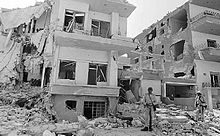
On October 9, Syrian FROG-7 surface-to-surface missiles struck the Israeli Air Force base of Ramat David, killing a pilot and injuring several soldiers. Additional missiles struck civilian settlements. In retaliation, seven Israeli F-4 Phantoms flew into Syria and struck the Syrian General Staff Headquarters in Damascus. The jets attacked from Lebanese airspace to avoid the heavily defended regions around the Golan Heights, attacking a Lebanese radar station along the way. The upper floors of the Syrian GHQ and the Air Force Command were badly damaged. A Soviet cultural centre, a television station, and other nearby structures were also mistakenly hit. One Israeli Phantom was shot down. The strike prompted the Syrians to transfer air defense units from the Golan Heights to the home front, allowing the Israeli Air Force greater freedom of action.
On October 9, as the last Syrian units were being ejected from the Golan Heights, the Syrians launched a counterattack north of Quneitra. As part of the operation, they attempted to land heli-borne troops in the vicinity of El Rom. The counterattack was repulsed, and four Syrian helicopters were shot down with total loss of life. By October 10, the last Syrian unit in the central sector had pushed back across the Purple Line (the pre-war ceasefire line).After four days of intense and incessant combat, the Israelis had succeeded in ejecting the Syrians from the entire Golan.
A decision now had to be made—whether to stop at the post-1967 border or to continue advancing into Syrian territory. The Israeli High Command spent all of October 10 debating this well into the night. Some favored disengagement, which would allow soldiers to be redeployed to the Sinai ( Shmuel Gonen's defeat at Hizayon in the Sinai had taken place two days earlier). Others favored continuing the attack into Syria, towards Damascus, which would knock Syria out of the war; it would also restore Israel's image as the supreme military power in the Middle East and would give Israel a valuable bargaining chip once the war ended.
Others countered that Syria had strong defenses—antitank ditches, minefields, and strongpoints— and that it would be better to fight from defensive positions in the Golan Heights (rather than the flat terrain deeper in Syria) in the event of another war with Syria. However, Prime Minister Golda Meir realized the most crucial point of the whole debate:
It would take four days to shift a division to the Sinai. If the war ended during this period, the war would end with a territorial loss for Israel in the Sinai and no gain in the north—an unmitigated defeat. This was a political matter and her decision was unmitigating—to cross the purple line... The attack would be launched tomorrow, Thursday, October 11.
Israeli advance
On October 11, Israeli forces pushed into Syria and advanced towards Damascus along the Quneitra-Damascus road until October 14, encountering stiff resistance by Syrian reservists in prepared defenses. Three Israeli divisions broke the first and second defensive lines near Sasa, and conquered a further 50 square kilometers of territory in the Bashan salient. From there, they were able to shell the outskirts of Damascus, only 40 km away, using M107 heavy artillery.
On October 12, Israeli paratroopers from the elite Sayeret Tzanhanim reconnaissance unit launched Operation Gown, infiltrating deep into Syria and destroying a bridge in the tri-border area of Syria, Iraq, and Jordan. The operation disrupted the flow of weapons and troops to Syria. During the operation, the paratroopers destroyed a number of tank transports and killed several Syrian soldiers. There were no Israeli casualties.
As the Syrian position deteriorated, Jordan sent an expeditionary force into Syria. King Hussein, who had come under intense pressure to enter the war, told Israel of his intentions through US intermediaries, in the hope that Israel would accept that this was not a casus belli justifying an attack on Jordan. Israeli Defense Minister Moshe Dayan declined to offer any such assurance, but said that Israel had no intention of opening another front. Iraq also sent an expeditionary force to Syria, consisting of the 3rd Armoured Division, 6th Armoured Division, some 30,000 men, 250–500 tanks, and 700 APCs. Israeli jets attacked Iraqi forces as they arrived in Syria.
The Iraqi divisions were a strategic surprise for the IDF, which expected 24-hour-plus advance intelligence of such moves. This turned into an operational surprise, as the Iraqis attacked the exposed southern flank of the advancing Israeli armor, forcing its advance units to retreat a few kilometers in order to prevent encirclement. Combined Syrian, Iraqi and Jordanian counterattacks prevented any further Israeli gains. However, they were also unable to push the Israelis back from the Bashan salient, and suffered heavy losses in their engagements with the Israelis. The most effective attack took place on October 20, though Arab forces lost 120 tanks in that engagement.
The Syrian Air Force attacked Israeli columns, but its operations were highly limited due to Israeli air superiority, and it suffered heavy losses in dogfights with Israeli jets. On October 23, a large air battle took place near Damascus during which the Israelis shot down 10 Syrian aircraft. The Syrians claimed a similar toll against Israel. The IDF also destroyed the Syrian missile defense system. The Israeli Air Force utilized its air superiority to attack strategic targets throughout Syria, including important power plants, petrol supplies, bridges and main roads. The strikes damaged the Syrian war effort, disrupted Soviet efforts to airlift military equipment into Syria, and disrupted normal life inside the country.
On October 22, the Golani Brigade and Sayeret Matkal commandos recaptured the outpost on Mount Hermon, after a hard fought battle that involved hand-to-hand combat and Syrian sniper attacks. An unsuccessful attack two weeks prior had cost the Israelis 23 dead and 55 wounded and the Syrians 29 dead and 11 wounded, while this second attack cost Israel an additional 55 dead and 79 wounded. An unknown number of Syrians were also killed and some were taken prisoner. An IDF D9 bulldozer supported by infantry forced its way to the peak. An Israeli paratroop force, landing by helicopter took the corresponding Syrian Hermon outposts on the mountain, killing more than a dozen Syrians while losing one dead and four wounded. Seven Syrian MiGs and two Syrian helicopters carrying reinforcements were shot down as they attempted to intercede.
Northern front de-escalation
The Syrians prepared for a massive counteroffensive to drive Israeli forces out of Syria, scheduled for October 23. A total of five Syrian divisions were to take part, alongside the Iraqi and Jordanian expeditionary forces. The Soviets had replaced most of the losses Syria's tank forces had suffered during the first weeks of the war.
However, the day before the offensive was to begin, the United Nations imposed its ceasefire (following the acquiescence of both Israel and Egypt). Abraham Rabinovich claimed that "The acceptance by Egypt of the cease-fire on Monday [October 22] created a major dilemma for Assad. The cease-fire did not bind him, but its implications could not be ignored. Some on the Syrian General Staff favored going ahead with the attack, arguing that if it did so Egypt would feel obliged to continue fighting as well... Others, however, argued that continuation of the war would legitimize Israel's efforts to destroy the Egyptian Third Army. In that case, Egypt would not come to Syria's assistance when Israel turned its full might northward, destroying Syria's infrastructure and perhaps attacking Damascus".
Ultimately, Syrian President Hafez al-Assad decided to cancel the offensive. On October 23, the day the offensive was to begin, Syria announced that it had accepted the ceasefire, and ordered its troops to cease-fire, while the Iraqi government ordered its forces home.
Following the UN ceasefire, there were constant artillery exchanges and skirmishes, and Israeli forces continued to occupy positions deep within Syria. According to Syrian Foreign Minister Abdel Halim Khaddam, Syria's constant artillery attacks were "part of a deliberate war of attrition designed to paralyse the Israeli economy", and were intended to pressure Israel into yielding the occupied territory. Some aerial engagements took place, and both sides lost several aircraft. In spring 1974, the Syrians attempted to retake the summit of Mount Hermon. The fighting lasted for more than a month and saw heavy losses on both sides, but the Israelis held their positions. The situation continued until a May 1974 disengagement agreement.
Jordanian Participation
Though King Hussein of Jordan initially refrained from entering the conflict, on the night of October 12–13 Jordanian troops deployed to the Jordanian-Syrian frontier to buttress Syrian troops, and Jordanian forces joined Syrian and Iraqi assaults on Israeli positions on October 16 and October 19. Hussein sent a second brigade to the Golan front on October 21.
At sea
On the first day of the war, Egyptian missile boats bombarded the Sinai Mediterranean ports of Rumana and Ras Beyron, Ras Masala and Ras Sudar on the Gulf of Suez, and Sharm el-Sheikh. Egyptian naval frogmen also raided the oil installations at Bala'eem, disabling the massive driller.
The Battle of Latakia, a revolutionary naval battle between the Israeli and Syrian navies, took place on October 7, the second day of the war. Five Israeli missile boats had been heading towards the Syrian port of Latakia, and sank a Syrian torpedo boat and minesweeper before encountering five Syrian missile boats. The Israelis used electronic countermeasures and chaff rockets to evade Syrian missiles, then sank all five Syrian missile boats. This revolutionary engagement, the first between missile boats using surface-to-surface missiles, proved the potency of small, fast missile boats equipped with advanced ECM packages. The battle also established the Israeli Navy, long derided as the " black sheep" of the Israeli military, as a formidable and effective force in its own right.
On October 10–11, another engagement took place when Israeli missile boats fired into the port of Latakia, targeting two Syrian missile boats spotted maneuvering among merchant ships in the port. Both Syrian vessels were sunk, and two merchant ships were mistakenly hit and sunk.
On October 7, the Israeli Navy defeated the Egyptian Navy in what became known as the Battle of Marsa Talamat. Two Israeli Dabur class patrol boats were patrolling in the Gulf of Suez, and encountered two Egyptian Zodiac boats loaded with Egyptian naval commandos, a patrol boat, and coastal guns. The Israeli patrol boats sank both Zodiacs and the patrol boat. Both Israeli patrol boats suffered damage during the battle.
The second naval battle which ended in a decisive Israeli victory was the Battle of Baltim, which took place on October 8–9 off the coast of Baltim and Damietta. Six Israeli missile boats heading towards Port Said encountered four Egyptian missile boats coming from Alexandria. In an engagement lasting about forty minutes, the Israelis evaded Egyptian Styx missiles using electronic countermeasures and sank three of the Egyptian missile boats with Gabriel missiles and gunfire. The Battles of Latakia and Baltim "drastically changed the operational situation at sea to Israeli advantage".
Five nights after the Battle of Baltim, five Israeli patrol boats entered the Egyptian anchorage at Ras Ghareb, where over fifty Egyptian small patrol craft, including armed fishing boats mobilized for the war effort that loaded with troops, ammunition and supplies bound for the Israeli side of the Gulf, were based. In the battle that followed, 19 Egyptian boats were sunk, while others remained bottled up in port.
The Israeli Navy had control of the Gulf of Suez during the war, which made possible the continued deployment of an Israeli SAM battery near an Israeli naval base close to the southern end of the Suez Canal, depriving the Egyptian Third Army of air support and preventing it from moving southward and attempting to capture the southern Sinai.
Israeli commandos from Shayetet 13, the Israeli Navy's elite special unit, infiltrated the Egyptian port of Arkada on the night of October 9–10 and sank a Kumar-class missile boat after four previous attempts had failed. After another infiltration attempt failed, the commandos successfully infiltrated Arkada again on the night of October 21–22 and heavily damaged a missile boat with M72 LAW rockets. During one of the raids, the commandos also blew up the port's main docking pier. On October 16, Shayetet 13 commandos infiltrated Port Said in two Hazir mini-submarines to strike Egyptian naval targets. During the raid, the commandos sank a torpedo boat, a coast guard boat, a tank landing craft, and a missile boat. Two frogmen went missing during the operation. On October 18, Israeli frogmen set off an explosion that severed two underwater communications cables off Beirut, one of which led to Alexandria and the other to Marseilles. As a result, telex and telecommunications between the West and Syria were severed, and were not restored until the cables were repaired on October 27. The cables had also been used by the Syrians and Egyptians to communicate with each other in preference to using radio, which was monitored by Israeli, US and Soviet intelligence. Egypt and Syria resorted to communicating via a Jordanian radio station in Ajloun, bouncing the signals off a US satellite.
On October 11, Israeli missile boats sank two Syrian missile boats in an engagement off Tartus. During the battle, a Soviet merchant ship was hit by Israeli missiles and sank.
During the last week of the war, Egyptian frogmen carried out three or four raids on Eilat. The attacks caused minor damage, but created some alarm.
Having decisively beaten the Egyptian and Syrian navies, the Israeli Navy had the run of the coastlines. Israeli missile boats utilized their 76mm cannons and other armaments to attack Syrian coastal oil installations, as well as radar stations and other targets of military value on both Syrian and Egyptian coastlines. The Israeli Navy even attacked some of Egypt's northernmost SAM batteries. The Israeli Navy's attacks were carried out with minimal support from the Israeli Air Force (only one Arab naval target was destroyed from the air during the entire war).
The Egyptian Navy managed to enforce a blockade at Bab-el-Mandeb. Eighteen million tons of oil had been transported yearly from Iran to Israel through the straits of Bab-el-Mandeb. The blockade was enforced by two Egyptian destroyers and two submarines, supported by ancillary craft. Shipping destined for Israel through the Gulf of Eilat was halted by the Egyptians. The Israeli Navy had no means of lifting the blockade due to the long range involved, and the Israeli Air Force, apparently also incapable of lifting the blockade, did not challenge it. The blockade was lifted on November 1, after Israel used the surrounded Egyptian Third Army as a bargaining chip. The Egyptians unsuccessfully attempted to blockade the Israeli Mediterranean coastline. The Egyptians also mined the Gulf of Suez to prevent the transportation of oil from the Bala'eem and Abu Rudeis oil fields in southwestern Sinai to Eilat in southern Israel. Two oil tankers, of 48,000 ton and 2,000 ton capacity, sank after hitting mines in the Gulf. According to Admiral Ze'ev Almog, the Israeli Navy escorted tankers from the Gulf to Eilat throughout the war, and Israeli tankers sailing from Iran were directed to bypass the Red Sea. As a result of these actions and the failure of Egypt's Mediterranean blockade, the transport of oil, grains and weapons to Israeli ports was made possible throughout nearly the entire war. A post-war survey found that during the entire war period, Israel suffered no oil shortages, and even sold oil to third parties affected by the Arab oil embargo. This claim was disputed by Edgar O'Ballance, who claimed that no oil went to Israel during the blockade, and the Eilat- Ashdod pipeline was empty by the end of the war.
Israel responded with a counter-blockade of Egypt in the Gulf of Suez. The Israeli blockade was enforced by naval vessels based at Sharm el-Sheikh and the Sinai coast facing the Gulf of Suez. The Israeli blockade substantially damaged the Egyptian economy. According to historian Gammal Hammad, Egypt's principal ports, Alexandria and Port Safaga, remained open to shipping throughout the war. Throughout the war, the Israeli Navy enjoyed complete command of the seas both in the Mediterranean approaches and in the Gulf of Suez.
According to Israeli and western sources, the Israelis lost no vessels in the war. Israeli vessels were "targeted by as many as 52 Soviet-made anti-ship missiles", but none hit their targets. According to historian Benny Morris, the Egyptians lost seven missile boats and four torpedo boats and coastal defense craft, while the Syrians lost five missile boats, one minesweeper, and one coastal defense vessel. All together, the Israeli Navy suffered three dead or missing and seven wounded.
Atrocities against Israeli prisoners
Syrian atrocities
Syria ignored the Geneva Conventions and many Israeli prisoners of war (POW) were reportedly tortured or killed. Advancing Israeli forces, re-capturing land taken by the Syrians early in the war, came across the bodies of 28 Israeli soldiers who had been blindfolded with their hands bound and summarily executed. In a December 1973 address to the National Assembly, Syrian Defense Minister Mustafa Tlass stated that he had awarded one soldier the Medal of the Republic for killing 28 Israeli prisoners with an axe, decapitating three of them and eating the flesh of one of his victims. The Syrians employed brutal interrogation techniques utilizing electric shocks to the genitals. A number of Israeli soldiers taken prisoner on Mount Hermon were executed. Near the village of Hushniye, the Syrians captured 11 administrative personnel from the Golan Heights Force, all of whom were later found dead, blindfolded and with their hands tied behind their backs. Within Hushniye, seven Israeli prisoners were found dead, and another three were executed at Tel Zohar. Syrian prisoners who fell into Israeli captivity confirmed that their comrades killed IDF prisoners.
Some Israeli POWs reported having their fingernails ripped out while others were described as being turned into human ashtrays as their Syrian guards burned them with lit cigarettes. A report submitted by the chief medical officer of the Israeli army notes that, “the vast majority of (Israeli) prisoners were exposed during their imprisonment to severe physical and mental torture. The usual methods of torture were beatings aimed at various parts of the body, electric shocks, wounds deliberately inflicted on the ears, burns on the legs, suspension in painful positions and other methods." Following the conclusion of hostilities, Syria would not release the names of prisoners it was holding to the International Committee of the Red Cross and in fact, did not even acknowledge holding any prisoners despite the fact they were publicly exhibited by the Syrians for television crews. The Syrians, having been thoroughly defeated by Israel, were attempting to use their captives as their sole bargaining chip in the post-war negotiations. One of the most famous Israeli POWs was Avraham Lanir, an Israeli pilot who bailed out over Syria and was taken prisoner. Lanir died under Syrian interrogation. When his body was returned in 1974, it exhibited signs of torture.
Egyptian atrocities
Israeli historian Aryeh Yitzhaki estimated that the Egyptians killed about 200 Israeli soldiers who had surrendered. Yitzhaki based his claim on army documents. In addition, dozens of Israeli prisoners were beaten and otherwise mistreated in Egyptian captivity.
Individual Israeli soldiers gave testimony of witnessing comrades killed after surrendering to the Egyptians, or seeing the bodies of Israeli soldiers found blindfolded with their hands tied behind their backs. Avi Yaffe, a radioman serving on the Bar-Lev Line, reported hearing calls from other soldiers that the Egyptians were killing anyone who tried to surrender, and also obtained recordings of soldiers who were saved from Egyptian firing squads. Photographic evidence of such executions exists, though some of it has never been made public. Photos were also found of Israeli prisoners who were photographed alive in Egyptian captivity, but were returned to Israel dead.
The order to kill Israeli prisoners came from General Shazly, who, in a pamphlet distributed to Egyptian soldiers immediately before the war, he advised his troops to kill Israeli soldiers even if they surrendered.
Soviet threat of intervention
On October 9, the Soviet cultural centre in Damascus was damaged during an Israeli airstrike, and two days later, the Soviet merchant ship Ilya Mechnikov was sunk by the Israeli Navy during a battle off Syria. The Soviets condemned Israeli actions, and there were calls within the government for military retaliation. The Soviets ultimately reacted by deploying two destroyers off the Syrian coast. Soviet warships in the Mediterranean were authorized to open fire on Israeli combatants approaching Soviet convoys and transports. There were several recorded instances of Soviet ships exchanging fire with Israeli forces. In particular, the Soviet minesweeper Rulevoi and the medium landing ship SDK-137, guarding Soviet transport ships at the Syrian port of Latakia, fired on approaching Israeli jets.
During the cease-fire, Henry Kissinger mediated a series of exchanges with the Egyptians, Israelis and the Soviets. On October 24, Sadat publicly appealed for American and Soviet contingents to oversee the ceasefire; it was quickly rejected in a White House statement. Kissinger also met with Soviet Ambassador Dobrynin to discuss convening a peace conference with Geneva as the venue. Later in the evening (9:35 pm) of October 24–25, Brezhnev sent Nixon a "very urgent" letter. In that letter, Brezhnev began by noting that Israel was continuing to violate the ceasefire and it posed a challenge to both the US and USSR. He stressed the need to "implement" the ceasefire resolution and "invited" the US to join the Soviets "to compel observance of the cease-fire without delay" He then threatened "I will say it straight that if you find it impossible to act jointly with us in this matter, we should be faced with the necessity urgently to consider taking appropriate steps unilaterally. We cannot allow arbitrariness on the part of Israel." The Soviets were threatening to militarily intervene in the war on Egypt's side if they could not work together to enforce the ceasefire.
Kissinger immediately passed the message to White House Chief of Staff Alexander Haig, who met with Nixon for 20 minutes around 10:30 pm, and reportedly empowered Kissinger to take any necessary action. Kissinger immediately called a meeting of senior officials, including Haig, Defense Secretary James Schlesinger, and CIA Director William Colby. The Watergate scandal had reached its apex, and Nixon was so agitated and discomposed that they decided to handle the matter without him:
When Kissinger asked Haig whether [Nixon] should be wakened, the White House chief of staff replied firmly 'No.' Haig clearly shared Kissinger's feelings that Nixon was in no shape to make weighty decisions.
The meeting produced a conciliatory response, which was sent (in Nixon's name) to Brezhnev. At the same time, it was decided to increase the Defense Condition (DEFCON) from four to three. Lastly, they approved a message to Sadat (again, in Nixon's name) asking him to drop his request for Soviet assistance, and threatening that if the Soviets were to intervene, so would the United States.
The Soviets placed seven airborne divisions on alert and airlift was marshaled to transport them to the Middle East. An airborne command post was set up in the southern Soviet Union, and several air force units were also alerted. "Reports also indicated that at least one of the divisions and a squadron of transport planes had been moved from the Soviet Union to an airbase in Yugoslavia". The Soviets also deployed seven amphibious warfare craft with some 40,000 naval infantry in the Mediterranean.
The Soviets quickly detected the increased American defense condition, and were astonished and bewildered at the response. "Who could have imagined the Americans would be so easily frightened," said Nikolai Podgorny. "It is not reasonable to become engaged in a war with the United States because of Egypt and Syria," said Premier Alexei Kosygin, while KGB chief Yuri Andropov added that "We shall not unleash the Third World War." The letter from the US cabinet arrived during the meeting. Brezhnev decided that the Americans were too nervous, and that the best course of action would be to wait to reply. The next morning, the Egyptians agreed to the American suggestion, and dropped their request for assistance from the Soviets, bringing the crisis to an end.
Participation by other states
Aid to Israel
Based on intelligence estimates at the commencement of hostilities, American leaders expected the tide of the war to quickly shift in Israel's favour, and that Arab armies would be completely defeated within 72 to 96 hours. On October 6, Secretary of State Kissinger convened the National Security Council's official crisis management group, the Washington Special Actions Group, which debated whether the U.S. should supply additional arms to Israel. High-ranking representatives of the Defense and State Departments opposed such a move. Kissinger was the sole dissenter; he said that if the US refused aid, Israel would have little incentive to conform to American views in postwar diplomacy. Kissinger argued the sending of U.S. aid might cause Israel to moderate its territorial claims, but this thesis raised a protracted debate whether U.S. aid was likely to make it more accommodating or more intransigent toward the Arab world.
By October 8, Israel had encountered military difficulties on both fronts. In the Sinai, Israeli efforts to break through Egyptian lines with armor had been thwarted, and while Israel had contained and begun to turn back the Syrian advance, Syrian forces were still overlooking the Jordan River and their air defense systems were inflicting a high toll on Israeli planes. It became clear by October 9 that no quick reversal in Israel's favour would occur and that IDF losses were unexpectedly high.
During the night of October 8–9, an alarmed Dayan told Meir that "this is the end of the third temple." He was warning of Israel's impending total defeat, but "Temple" was also the code word for nuclear weapons. Dayan again raised the nuclear topic in a cabinet meeting, warning that the country was approaching a point of "last resort." That night Meir authorized the assembly of thirteen 20-kiloton-of-TNT (84 TJ) tactical atomic weapons for Jericho missiles at Sdot Micha Airbase, and F-4 aircraft at Tel Nof Airbase, for use against Syrian and Egyptian targets. They would be used if absolutely necessary to prevent total defeat, but the preparation was done in an easily detectable way, likely as a signal to the United States. Kissinger learned of the nuclear alert on the morning of October 9. That day, President Nixon ordered the commencement of Operation Nickel Grass, an American airlift to replace all of Israel's material losses. Anecdotal evidence suggests that Kissinger told Sadat that the reason for the U.S. airlift was that the Israelis were close to "going nuclear." European countries refused to allow US airplanes carrying supplies for Israel to refuel at their bases, fearing an Arab oil embargo, with the exception of Portugal and the Netherlands. Portugal permitted the United States to use a leased base in Azores, and the defence minister of the Netherlands, apparently acting without consulting his cabinet colleagues, secretly authorised the use of Dutch airfields.
Israel began receiving supplies via US Air Force cargo airplanes on October 14, although some equipment had arrived on planes from Israel's national airline El Al before this date. By that time, the IDF had advanced deep into Syria and was mounting a largely successful invasion of the Egyptian mainland from the Sinai, but had taken severe material losses. According to Abraham Rabinovich, "while the American airlift of supplies did not immediately replace Israel's losses in equipment, it did allow Israel to expend what it did have more freely". By the end of Nickel Grass, the United States had shipped 22,395 tons of matériel to Israel. 8,755 tons of it arrived before the end of the war. American C-141 Starlifter and C-5 Galaxy aircraft flew 567 missions throughout the airlift. El Al planes flew in an additional 5,500 tons of matériel in 170 flights. The airlift continued after the war until November 14. The United States also delivered approximately 90,000 tons of matériel to Israel by sealift until the beginning of December, using 16 ships. 33,210 tons of it arrived by October 30.
By the beginning of December, Israel had received between 34 to 40 F-4 fighter-bombers, 46 A-4 attack airplanes, 12 C-130 cargo airplanes, 8 CH-53 helicopters, 40 unmanned aerial vehicles, 200 M-60/ M-48A3 tanks, 250 armored personnel carriers, 226 utility vehicles, 12 MIM-72 Chaparral surface-to-air missile systems, 3 MIM-23 Hawk surface-to-air missile systems, 36 155 mm artillery pieces, 7 175 mm artillery pieces, large quantities of 105 mm, 155 mm and 175 mm ammunition, state of the art equipment, such as the AGM-65 Maverick missile and the BGM-71 TOW, weapons that had only entered production one or more years prior, as well as highly advanced electronic jamming equipment. Most of the combat airplanes arrived during the war, and many were taken directly from United States Air Force units. Most of the large equipment arrived after the ceasefire. The total cost of the equipment was approximately US$800 million (US$4.19 billion today).
On October 13 and 15, Egyptian air defense radars detected an aircraft at an altitude of 25,000 metres (82,000 ft) and a speed of Mach 3, making it impossible to intercept either by fighter or SAM missiles. The aircraft proceeded to cross the whole of the canal zone, the naval ports of the Red Sea (Hurghada and Safaga), flew over the airbases and air defenses in the Nile delta, and finally disappeared from radar screens over the Mediterranean Sea. The speed and altitude were those of the US SR-71 Blackbird, a long-range strategic-reconnaissance aircraft. According to Egyptian commanders, the intelligence provided by the reconnaissance flights helped the Israelis prepare for the Egyptian attack on October 14 and assisted it in conducting Operation Stouthearted Men.
Aid to Egypt and Syria
Soviet Aid
Starting on October 9, the Soviet Union began supplying Egypt and Syria by air and by sea. The Soviets airlifted 12,500–15,000 tons of supplies, of which 6,000 tons went to Egypt, 3,750 tons went to Syria and 575 tons went to Iraq. General Shazly, the former Egyptian chief of staff, claimed that more than half of the airlifted Soviet hardware actually went to Syria. According to Ze'ev Schiff, Arab losses were so high and the attrition rate so great that equipment was taken directly from Soviet and Warsaw Pact stores to supply the airlift. Antonov An-12 and AN-22 aircraft flew over 900 missions during the airlift.
The Soviets supplied another 63,000 tons, mainly to Syria, by means of a sealift by October 30. Historian Gamal Hammad asserts that 400 T-55 and T-62 tanks supplied by the sealift were directed towards replacing Syrian losses, transported from Odessa on the Black Sea to the Syrian port of Latakia. Hammad claimed that Egypt did not receive any tanks from the Soviets, a claim disputed by Schiff, who stated that Soviet freighters loaded with tanks and other weapons reached Egyptian, Algerian and Syrian ports throughout the war. The sealift may have included Soviet nuclear weapons, which were not unloaded but kept in Alexandria harbour until November to counter the Israeli nuclear preparations, which Soviet satellites had detected. American concern over possible evidence of nuclear warheads for the Soviet Scud missiles in Egypt contributed to Washington's decision to go to DEFCON 3.
On the Golan front, Syrian forces received direct support from Soviet technicians and military personnel. At the start of the war, there were an estimated 2,000 Soviet personnel in Syria, of whom 1,000 were serving in Syrian air defense units. Soviet technicians repaired damaged tanks, SAMs and radar equipment, assembled fighter jets that arrived via the sealift, and drove tanks supplied by the sealift from ports to Damascus. On both the Golan and Sinai fronts, Soviet military personnel retrieved abandoned Israeli military equipment for shipment to Moscow. Soviet advisors were reportedly present in Syrian command posts "at every echelon, from battalion up, including supreme headquarters". Some Soviet military personnel went into battle with the Syrians, and it was estimated that 20 were killed in action and more were wounded. In July 1974, Israeli Defense Minister Shimon Peres informed the Knesset that high-ranking Soviet officers had been killed on the Syrian front during the war. There were strong rumors that a handful were taken prisoner, but this was denied. However, it was noted that certain Soviet Jews were allowed to emigrate just after the war, leading to suspicions of a covert exchange. The Observer wrote that seven Soviets in uniform were taken prisoner after surrendering when the Israelis overran their bunker. The Israelis reportedly took the prisoners to Ramat David Airbase for interrogation, and treated the incident with great secrecy.
Israeli military intelligence reported that Soviet-piloted MiG-25 Foxbat interceptor/reconnaissance aircraft conducted flyovers over the Canal Zone.
Other countries
In total, Arab countries added up to 100,000 troops to Egypt and Syria's frontline ranks. Besides Egypt, Syria, Jordan, and Iraq, several other Arab states were also involved in this war, providing additional weapons and financing.
However, nearly all Arab reinforcements came with no logistical plan or support, expecting their hosts to supply them, and in several cases causing logistical problems. On the Syrian front, a lack of coordination between Arab forces led to several instances of friendly fire.
16 Pakistan Air Force pilots volunteered to leave for the Middle East in order to support Egypt and Syria but by the time they arrived Egypt had already agreed on a cease-fire. Syria remained in a state of war against Israel so the PAF pilots became instructors there and formed the A-flight of 67 Squadron at Dumayr AB. One of the PAF pilots, Flt. Lt. Sattar Alvi flying a MiG-21 shot down an Israeli Air Force Mirage and was honoured by the Syrian government.
Algeria sent a squadron each of MiG-21s and Su-7s to Egypt, which arrived at the front between October 9 and October 11. It also sent an armored brigade of 150 tanks, the advance elements of which began to arrive on October 17, but reached the front only on October 24, too late to participate in the fighting. After the war, during the first days of November, Algeria deposited around US$200 million with the Soviet Union to finance arms purchases for Egypt and Syria.
Libya, which had forces stationed in Egypt before the outbreak of the war, provided one armored brigade and two squadrons of Mirage V fighters, of which one squadron was to be piloted by the Egyptian Air Force and the other by Libyan pilots. Libya also sent financial aid. Morocco sent one infantry brigade to Egypt and one armored regiment to Syria. An infantry brigade composed of Palestinians was in Egypt before the outbreak of the war. Saudi Arabia and Kuwait each sent 3,000 soldiers to Syria. These arrived with additional Jordanian and Iraqi reinforcements in time for a new Syrian offensive scheduled for October 23, which was later cancelled. Kuwaiti troops were also sent to Egypt. Saudi Arabia and Kuwait also provided financial aid. Tunisia sent 1,000–2,000 soldiers to Egypt, where they were stationed in the Nile Delta and some of them were stationed to defend Port Said. Lebanon sent radar units to Syria for air defense. Sudan deployed a 3,500-strong infantry brigade to Egypt. It arrived on October 28, too late to participate in the war.
In addition to its forces in Syria, Iraq sent a single Hawker Hunter squadron to Egypt. The squadron quickly gained a reputation amongst Egyptian field commanders for its skill in air support, particularly in anti-armor strikes.
Cuba sent approximately 4,000 troops, including tank and helicopter crews to Syria, and they reportedly engaged in combat operations against the IDF. North Korea sent 20 pilots and 19 non-combat personnel to Egypt. The unit had four to six encounters with the Israelis from August through the end of the war. According to Shlomo Aloni, the last aerial engagement on the Egyptian front, which took place on December 6, saw Israeli F-4s engage North Korean-piloted MiG-21s. The Israelis shot down one MiG, and another was mistakenly shot down by Egyptian air defenses. Egyptian sources said that the North Koreans suffered no losses but claimed no aerial victories in their engagements.
Weapons
The Arab armies were equipped with predominantly Soviet-made weapons while Israel's armaments were mostly Western-made. The Arabs' T-54/55s and T-62s were equipped with night vision equipment, which the Israeli tanks lacked, giving them an advantage in fighting at night, while Israel tanks had better armor and/or better armament. Israeli tanks also had a distinct advantage in the “ hull-down” position where steeper angles of depression resulted in less exposure. The main guns of Soviet tanks could only depress 4 degrees. By contrast, the 105 mm guns on Centurion and Patton tanks could depress 10 degrees.
| Type | Arab armies | IDF |
|---|---|---|
| AFVs | Egypt, Syria and Iraq used T-34/85, T-54, T-55, T-62 and PT-76, as well as SU-100/ 152 World War II vintage self-propelled guns. | M50 and M51 Shermans with upgraded engines, M48A5 Patton, M60A1 Patton, Centurion and about 200 T-54/55 captured during the Six-Day War. All tanks were upgraded with the British 105 mm L7 gun, prior to the war. |
| APCs/ IFVs | BTR-40, BTR-152, BTR-50, BTR-60 APC's & BMP 1 IFV's | M2 /M3 Half-track, M113 |
| Artillery | M1937 Howitzer, BM-21, D-30 (2A18) Howitzer, M1954 field gun | M109 self-propelled howitzer, M107 Self-Propelled Gun, M110 self-propelled howitzer, M50 self-propelled howitzer and Makmat 160 mm self-propelled mortar, Obusier de 155 mm Modèle 50, Soltam M-68 and 130 mm towed field gun M1954 (M-46) |
| Aircraft | MiG-21, MiG-19, MiG-17, Su-7B, Tu-16, Il-28, Il-18, Il-14, An-12, Aero L-29 | A-4 Skyhawk, F-4 Phantom II, Dassault Mirage III, Dassault Super Mystère, IAI Nesher |
| Helicopters | Mi-6, Mi-8 | Super Frelon, CH-53, AB-205 |
| AAW | SA-6 Gainful, SA-3 Goa, SA-2 Guideline, ZSU-23-4, Strela 2 | MIM-23 Hawk, MIM-72/M48 Chaparral, Bofors 40 mm |
| Infantry weapons | Port Said submachinegun, AK-47, RPK, RPD, DShK HMG, AT-3 Sagger, RPG-7 and B-11 recoilless rifle | Uzi, FN FAL, AK-47, FN MAG, M2 Browning, Nord SS.11, LAW, TOW, RL-83 Blindicide and M40 recoilless rifle |
| Sea to Sea Missiles | P-15 Termit | Gabriel missile |
| Air-to-Air Missiles | Vympel K-13 | Shafrir 2, AIM-9 Sidewinder, AIM-7 Sparrow |
| Air-to-Ground Missiles | AGM-45 Shrike anti radiation missile |
Home front during the war
The war created a state of emergency in the countries involved in fighting. Upon the outbreak of war, air raid sirens sounded throughout Israel. During the war, blackouts were enforced in major cities. The Egyptian government began to evacuate foreign tourists, and on October 11, 1973, the Egyptian ship Syria left Alexandria to Piraeus with a load of tourists wishing to exit Egypt. The US Interest Section in Cairo also requested US government assistance in removing US tourists to Greece. On October 12, Kissinger ordered the US Interest Section in Cairo to speed up preparations for the departure of US tourists staying in Egypt, while notifying such actions to the IDF in order to avoid accidental military operations against them.
Post-ceasefire negotiations
Kissinger pushes for peace
On October 24, the UNSC passed Resolution 339, serving as a renewed call for all parties to adhere to the ceasefire terms established in Resolution 338. Most heavy fighting on the Egyptian front ended by October 26, but clashes along the ceasefire lines and a few airstrikes on the Third Army took place. With some Israeli advances taking place, Kissinger threatened to support a UN withdrawal resolution, but before Israel could respond, Egyptian national security advisor Hafez Ismail sent Kissinger a stunning message—Egypt was willing to enter into direct talks with Israel, provided that it agree to allow non-military supplies to reach the Third Army and to a complete ceasefire.
About noon on October 25, Kissinger appeared before the press at the State Department. He described the various stages of the crisis and the evolution of US policy. He reviewed the first two weeks of the crisis and the nuclear alert, reiterated opposition to US and Soviet troops in the area and more strongly opposed unilateral Soviet moves. He then reviewed the prospects for a peace agreement, which he termed “quite promising”, and had conciliatory words for Israel, Egypt and even the USSR. Kissinger concluded his remarks by spelling out the principles of a new US policy toward the Arab–Israeli conflict saying:
Our position is that... the conditions that produced this war were clearly intolerable to the Arab nations and that in the process of negotiations it will be necessary to make substantial concessions. The problem will be to relate the Arab concern for the sovereignty over the territories to the Israeli concern for secure boundaries. We believe that the process of negotiations between the parties is an essential component of this.
Quandt considers, “It was a brilliant performance, one of his most impressive.” One hour later the United Nations Security Council adopted Resolution 340. This time the ceasefire held, and the fourth Arab–Israeli war was over.
From disengagement to peace
Disengagement talks took place on October 28, 1973, at "Kilometer 101" between Israeli Major General Aharon Yariv and Egyptian Major General Abdel Ghani el-Gamasy. Ultimately, Kissinger took the proposal to Sadat, who agreed. United Nations checkpoints were brought in to replace Israeli ones, nonmilitary supplies were allowed to pass, and prisoners-of-war were to be exchanged.
A summit conference in Geneva followed in December 1973. All parties to the war – Israel, Syria, Jordan and Egypt – were invited to a joint effort by the Soviet Union and the United States to finally usher peace between the Arabs and Israelis. This conference was recognized by UN Security Council Resolution 344 and was based on the Resolution 338, calling for a “just and durable peace”. Nevertheless, the conference was forced to adjourn on January 9, 1974, as Syria refused attendance.
After the failed conference Henry Kissinger started conducting shuttle diplomacy, meeting with Israel and the Arab states directly. The first concrete result of this was the initial military disengagement agreement, signed by Israel and Egypt on January 18, 1974. The agreement commonly known as Sinai I had the official name of Sinai Separation of Forces Agreement. Under its terms, Israel agreed to pull back its forces from the areas West of Suez Canal which it had occupied since the end of hostilities. Moreover, Israeli forces were also pulled back on the length of the whole front to create security zones for Egypt, UN and Israel, each roughly ten kilometers wide. Thus Israel gave up its advances reaching beyond the Suez canal, but it still held nearly all of Sinai. It became the first of many such Land for Peace agreements where Israel gave up territory in exchange for treaties.
Another Egyptian-Israeli disengagement agreement, the Sinai Interim Agreement, was signed in Geneva on September 4, 1975, and was commonly known as Sinai II. This agreement led Israel to withdraw from another 20–40 km with UN forces buffering the vacated area. After the agreement, Israel still held more than two thirds of Sinai, which would prove to be a valuable bargaining chip in the coming negotiations.
On the Syrian front, skirmishes and artillery exchanges continued taking place. Shuttle diplomacy by Henry Kissinger eventually produced a disengagement agreement on May 31, 1974, based on exchange of prisoners-of-war, Israeli withdrawal to the Purple Line and the establishment of a UN buffer zone. The agreement ended the skirmishes and exchanges of artillery fire that had occurred frequently along the Israeli-Syrian ceasefire line. The UN Disengagement and Observer Force (UNDOF) was established as a peacekeeping force in the Golan.
A peace agreement between Israel and Egypt was finally reached in September 17, 1978 in the famous Camp David Accords after negotiations hosted by president Jimmy Carter. In accordance with the treaty, Israeli forces withdrew gradually from Sinai with last troops exiting on April 26, 1982. There is still no formal peace agreement between Israel and Syria to this day.
Casualties
Israel suffered between 2,521 and 2,800 killed in action. An additional 7,250 to 8,800 soldiers were wounded. Some 293 Israelis were captured. Approximately 400 Israeli tanks were destroyed. Another 600 were disabled but returned to service after repairs. A major Israeli advantage, noted by many observers, was their ability to quickly return damaged tanks to combat. The Israeli Air Force lost 102 airplanes: 32 F-4s, 53 A-4s, 11 Mirages and 6 Super Mysteres. Two helicopters, a Bell 205 and a CH-53, were also lost. According to Defense Minister Moshe Dayan, nearly half of these were shot down during the first three days of the war. IAF losses per combat sortie were less than in the preceding Six Day War of 1967.
Arab casualties were known to be much higher than Israel's, though precise figures are difficult to ascertain as Egypt and Syria never disclosed official figures. The lowest casualty estimate is 8,000 (5,000 Egyptian and 3,000 Syrian) killed and 18,000 wounded. The highest estimate is 18,500 (15,000 Egyptian and 3,500 Syrian) killed. Most estimates lie somewhere in between the two, with the Insight Team of the The Sunday Times of London claiming combined Egyptian and Syrian losses of 16,000 killed and yet another source citing a figure of some 15,000 dead and 35,000 wounded. U.S. estimates placed Egyptian casualties at 13,000. Iraq lost 278 killed and 898 wounded, while Jordan suffered 23 killed and 77 wounded. Some 8,372 Egyptians, 392 Syrians, 13 Iraqis and 6 Moroccans were taken prisoner.
Arab tank losses amounted to 2,250 though Garwych cites a figure of 2,300. 400 of these fell into Israeli hands in good working order and were incorporated into Israeli service. Between 341 and 514 Arab aircraft were shot down. According to Herzog, 334 of these aircraft were shot down by the Israeli Air Force in air-to-air combat for the loss of only five Israeli planes. The Insight Team of The Sunday Times notes Arab aircraft losses of 450. 19 Arab naval vessels, including 10 missile boats, were sunk for no Israeli losses.
Long-term effects
The peace discussion at the end of the war was the first time that Arab and Israeli officials met for direct public discussions since the aftermath of the 1948 war.
Response in Israel
Though the war reinforced Israel’s military deterrence, it had a stunning effect on the population in Israel. Following their victory in the Six-Day War, the Israeli military had become complacent. The shock and sudden reversals that occurred at the beginning of the war inflicted a terrible psychological blow to the Israelis, who had hitherto experienced no serious military challenges.
A protest against the Israeli government started four months after the war ended. It was led by Motti Ashkenazi, commander of Budapest, the northernmost of the Bar-Lev forts and the only one during the war not to be captured by the Egyptians. Anger against the Israeli government (and Dayan in particular) was high. Shimon Agranat, President of the Israeli Supreme Court, was asked to lead an inquiry, the Agranat Commission, into the events leading up to the war and the setbacks of the first few days.
The Agranat Commission published its preliminary findings on April 2, 1974. Six people were held particularly responsible for Israel's failings:
- Though his performance and conduct during the war was lauded, IDF Chief of Staff David Elazar was recommended for dismissal after the Commission found he bore "personal responsibility for the assessment of the situation and the preparedness of the IDF."
- Aman Chief, Aluf Eli Zeira, and his deputy, head of Research, Brigadier-General Aryeh Shalev, were recommended for dismissal.
- Lt. Colonel Bandman, head of the Aman desk for Egypt, and Lt. Colonel Gedelia, chief of intelligence for the Southern Command, were recommended for transfer away from intelligence duties.
- Shmuel Gonen, commander of the Southern front, was recommended by the initial report to be relieved of active duty. He was forced to leave the army after the publication of the Commission's final report, on January 30, 1975, which found that "he failed to fulfill his duties adequately, and bears much of the responsibility for the dangerous situation in which our troops were caught."
Rather than quieting public discontent, the report—which "had stressed that it was judging the ministers' responsibility for security failings, not their parliamentary responsibility, which fell outside its mandate"—inflamed it. Although it had absolved Meir and Dayan of all responsibility, public calls for their resignations (especially Dayan's) intensified. In the December 1973 legislative election, Meir's Alignment party lost five Knesset seats.
On April 11, 1974, Golda Meir resigned. Her cabinet followed suit, including Dayan, who had previously offered to resign twice and was turned down both times by Meir. A new government was seated in June, and Yitzhak Rabin, who had spent most of the war as an advisor to Elazar in an unofficial capacity, became Prime Minister.
In 1999, the issue was revisited by the Israeli political leadership to prevent similar shortcomings from being repeated. The Israeli National Security Council was created to improve coordination between the different security and intelligence bodies, and the political branch of government.
Response in Egypt and Syria
For the Arab states (and Egypt in particular), Arab successes during the war healed the psychological trauma of their defeat in the Six-Day War, allowing them to negotiate with the Israelis as equals. Due to the later setbacks in the war (which saw Israel gain a large salient on African soil and even more territory on the Syrian front), some believe that the war helped convince many in the Arab world that Israel could not be defeated militarily, thereby strengthening peace movements and ending the old Arab ambition of destroying Israel by force.
General Shazly had angered Sadat for advocating the withdrawal of Egyptian forces from Sinai to meet the Israeli incursion on the West Bank of the Canal. Six weeks after the war, he was relieved of command and forced out of the army, ultimately going into political exile for years. Upon his return to Egypt, he was placed under house arrest. Following his release, he advocated the formation of a "Supreme High Committee" modeled after Israel's Agranat Commission in order to “probe, examine and analyze” the performance of Egyptian forces and the command decisions made during the war, but his requests were completely ignored. He published a book, banned in Egypt, that described Egypt's military failings and the sharp disagreements he had with Ismail and Sadat in connection with the prosecution of the war.
The commanders of the Second and Third Armies, Generals Khalil and Wasel, were also dismissed from the army. The commander of the Egyptian Second Army at the start of the war, General Mamoun, suffered a heart attack, or, alternatively, a breakdown, after the Egyptian defeat during the October 14 Sinai tank battle, and was replaced by General Khalil.
In Syria, Colonel Rafik Halawi, the Druze commander of an infantry brigade that had collapsed during the Israeli breakthrough, was executed before the war even ended. He was given a quick hearing and sentenced to death; his execution was immediate. Military historian Zeev Schiff referred to him as Syria’s "sacrificial lamb". The Syrians however offered vehement denials that Halawi was executed and expended great efforts trying to debunk the allegation. They claimed he was killed in battle with Israel and threatened severe punishment to anyone repeating the allegation of execution. Their concern stemmed from a desire to maintain Syrian Druze loyalty to Assad’s regime and prevent Syrian Druze from siding with their co-religionists in Israel. On July 7, 1974, Halawi’s remains were removed from a Syrian military hospital and he was interred in Damascus at the "Cemetery of the Martyrs of the October War" in the presence of many Syrian dignitaries. One analyst noted that the presence of so many high-level officials was unusual and attributed it to Syrian efforts to quell any suggestion of execution.
Camp David Accords
The Yom Kippur War upset the status quo in the Middle East, and the war served as a direct antecedent of the 1979 Camp David Accords. The Accords resulted in the Israel-Egypt Peace Treaty, the first ever between Israel and an Arab state. According to George Friedman, the war gave the Israelis increased respect for the Egyptian military and decreased their confidence in their own, and caused the Israelis to be uncertain whether they could defeat Egypt in the event of another war. At the same time, the Egyptians recognized that despite their improvements, they were defeated in the end, and became doubtful that they could ever defeat Israel militarily. Therefore, a negotiated settlement made sense to both sides.
Rabin's government was hamstrung by a pair of scandals, and he was forced to step down in 1977. In the elections that followed, the right-wing Likud party won a majority in the Knesset, and Menachem Begin, the party's founder and leader, was appointed Prime Minister. This marked a historic change in the Israeli political landscape: for the first time since Israel's founding, a coalition not led by the Labor Party was in control of the government.
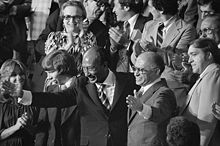
Sadat, who had entered the war in order to recover the Sinai from Israel, grew frustrated at the slow pace of the peace process. In a 1977 interview with CBS News anchorman Walter Cronkite, Sadat admitted under pointed questioning that he was open to a more constructive dialog for peace, including a state visit. This seemed to open the floodgates, as in a later interview with the same reporter, the normally hard-line Begin – perhaps not wishing to be compared unfavorably to Sadat – said he too would be amenable to better relations. On November 9, 1977, Sadat stunned the world when he told parliament that he would be willing to visit Israel and address the Knesset. Shortly afterward, the Israeli government cordially invited him to address the Knesset. Thus, in November of that year, Sadat took the unprecedented step of visiting Israel, becoming the first Arab leader to do so, and so implicitly recognized Israel.
The act jump-started the peace process. United States President Jimmy Carter invited both Sadat and Begin to a summit at Camp David to negotiate a final peace. The talks took place from September 5–17, 1978. Ultimately, the talks succeeded, and Israel and Egypt signed the Israel-Egypt Peace Treaty in 1979. Israel subsequently withdrew its troops and settlers in the Sinai, in exchange for normal relations with Egypt and a lasting peace.
Many in the Arab world were outraged at Egypt's peace with Israel. Sadat, in particular, became deeply unpopular both in the Arab world and in his own country. Egypt was suspended from the Arab League until 1989. Until then, Egypt had been "at the helm of the Arab world". Egypt's tensions with its Arab neighbors culminated in 1977 in the short-lived Libyan–Egyptian War.
Sadat was assassinated two years later on October 6, 1981, while attending a parade marking the eighth anniversary of the start of the war, by Islamist army members who were outraged at his negotiations with Israel.
Oil embargo
In response to U.S. support of Israel, the Arab members of OPEC, led by Saudi Arabia, decided to reduce oil production by 5% per month on October 17. On October 19, President Nixon authorized a major allocation of arms supplies and $2.2 billion in appropriations for Israel. In response, Saudi Arabia declared an embargo against the United States, later joined by other oil exporters and extended against the Netherlands and other states, causing the 1973 energy crisis.
Commemorations
October 6 is a national holiday in Egypt called Armed Forces Day. It is a national holiday in Syria as well, where it is called "Tishreen Liberation Day". Marking the 35th anniversary in 2006, Hosni Mubarak said that the conflict "breathed new life" into Egypt. He said Egypt and Syria's initial victories in the conflict eased Arab bitterness over Israel's victory in the 1967 Six-Day War and ultimately put the two nations on a path of peaceful coexistence.
In Egypt, many places were named after the October 6 date and Ramadan 10, its equivalent in the Islamic calendar. Examples of these commemorations are the October 6 Bridge in Cairo and the cities 6th of October City and 10th of Ramadan City.
The "Museum of October 6 War" was built in 1989 in the Heliopolis district of Cairo. The centre of the museum is occupied by a rotunda housing a panoramic painting of the struggle between Egyptian and Israeli armed forces. The panorama, the creation of which was outsourced to a group of North Korean artists and architects, is equipped with engines to rotate it 360° during a 30-minutes presentation accompanied by commentary in various languages. A similar museum, which was also built with North Korean assistance—the October War Panorama—operates in Damascus.
In Israel, a Yom Kippur War exhibit can be found at The Armored Corps Museum at Yad La-Shiryon.


